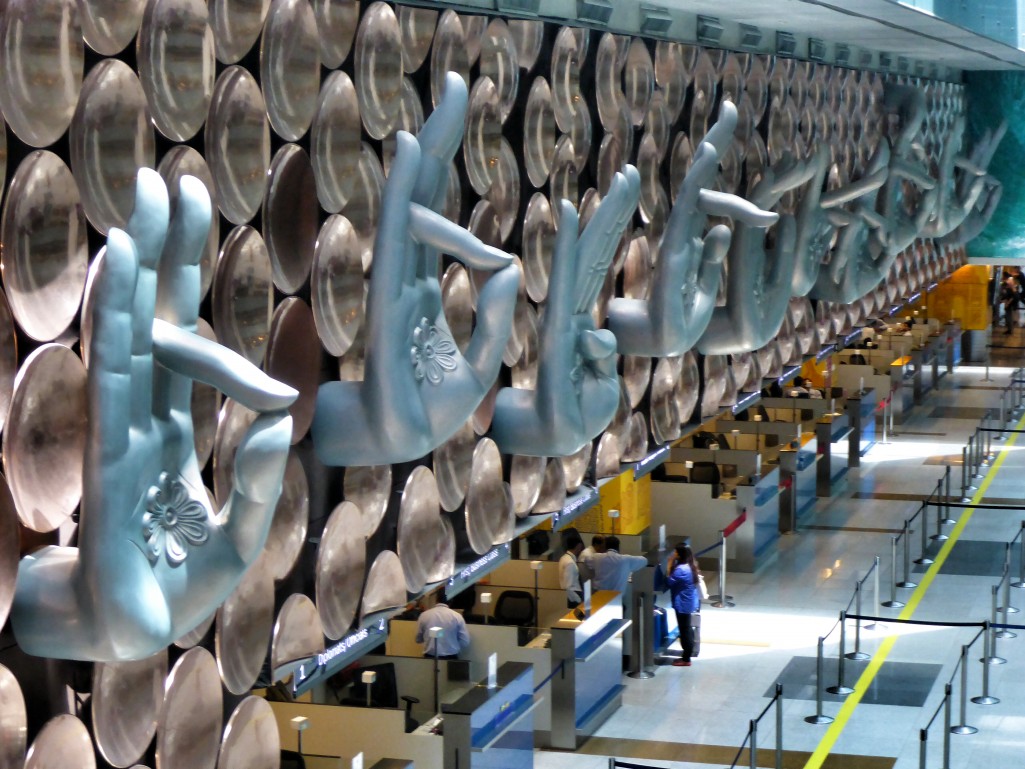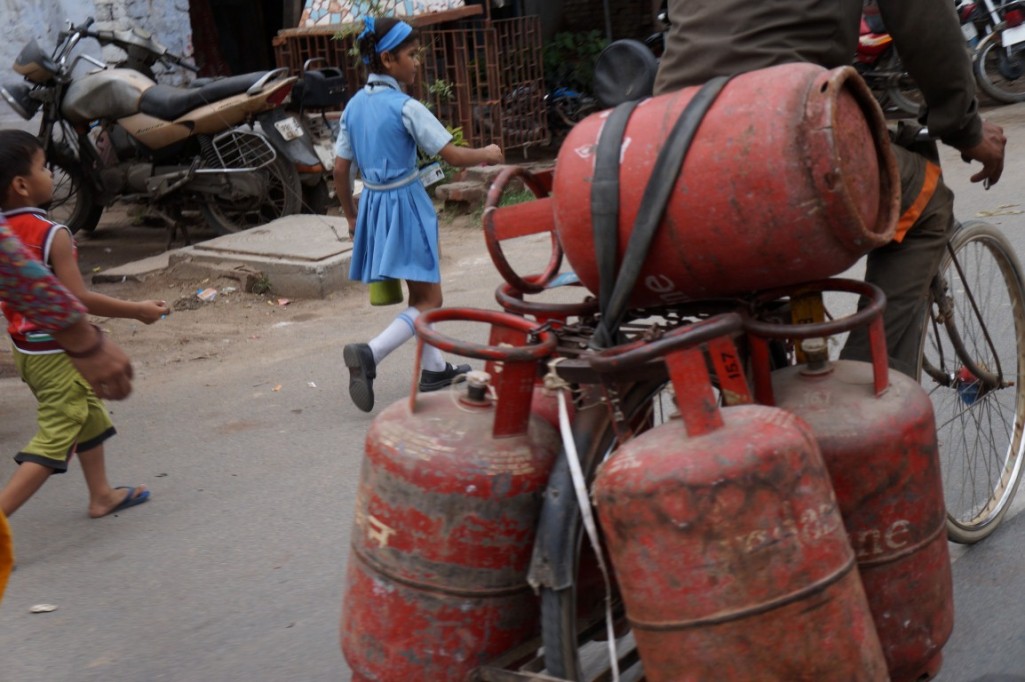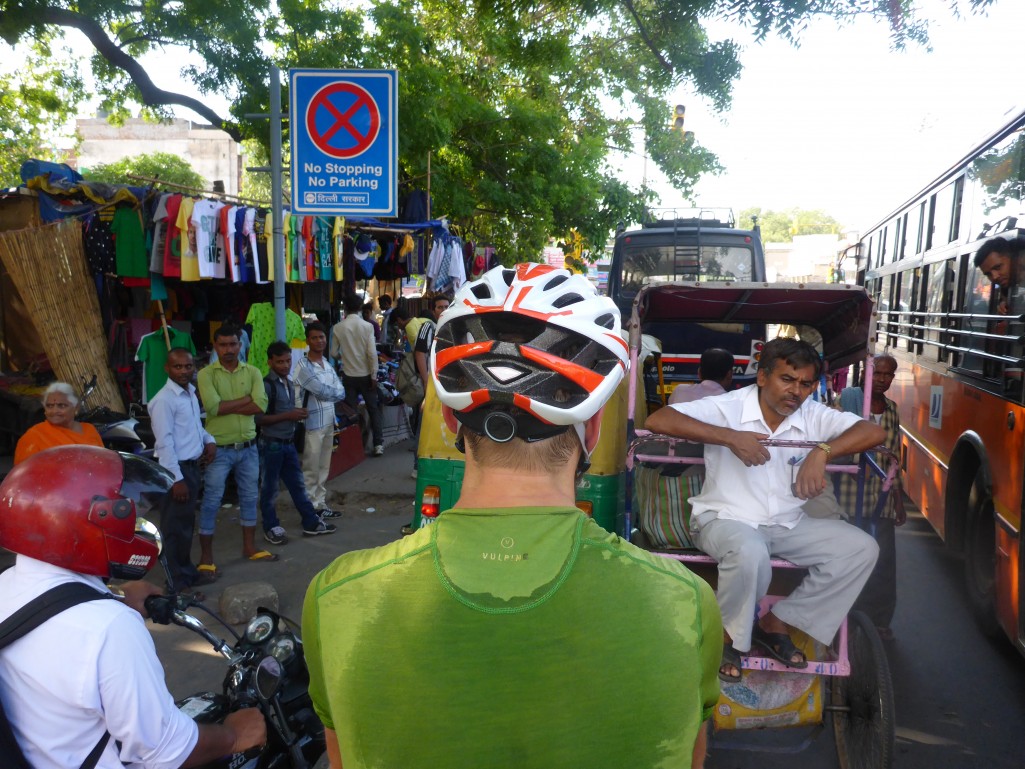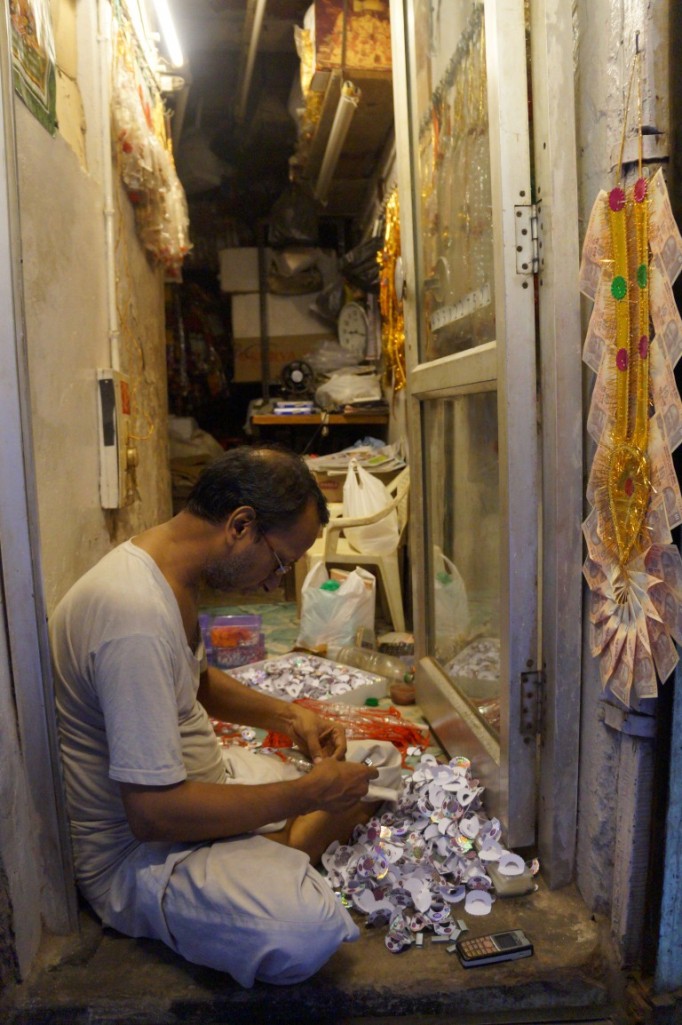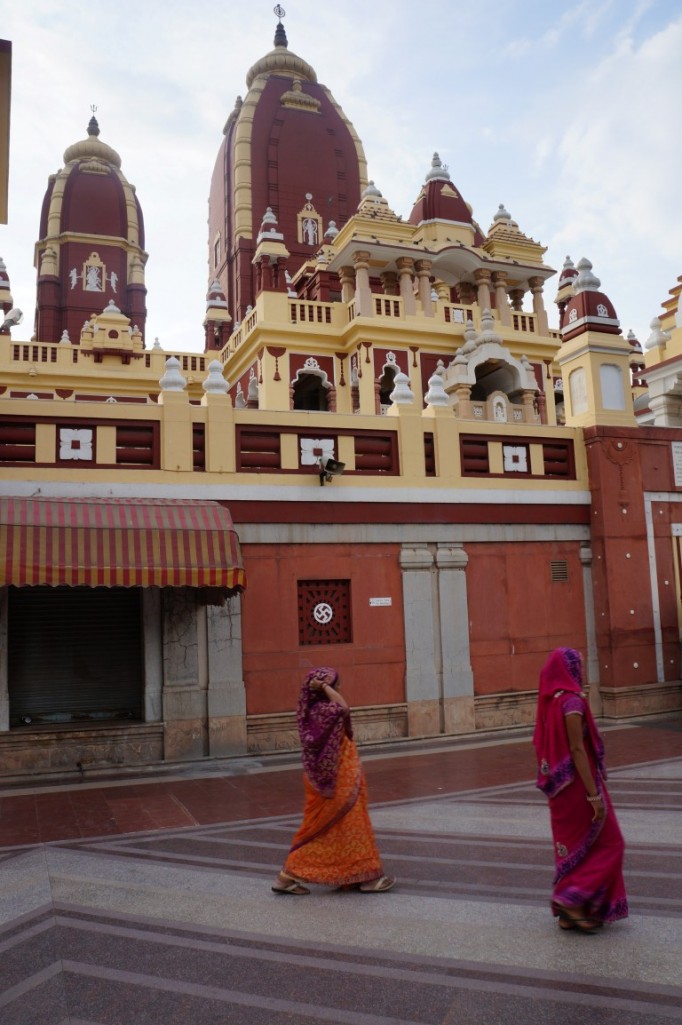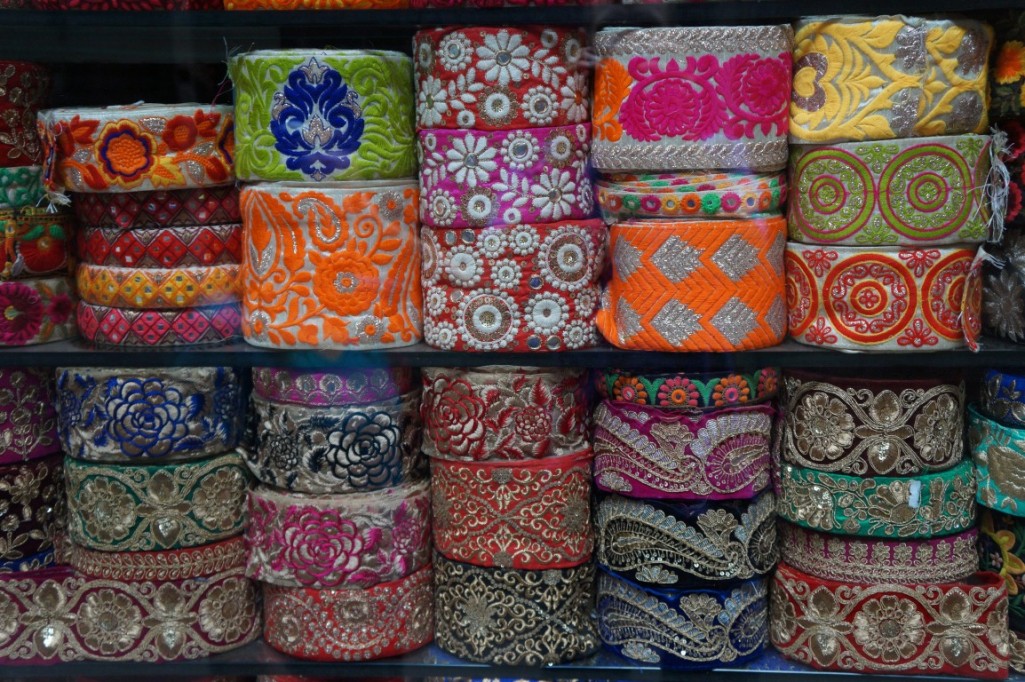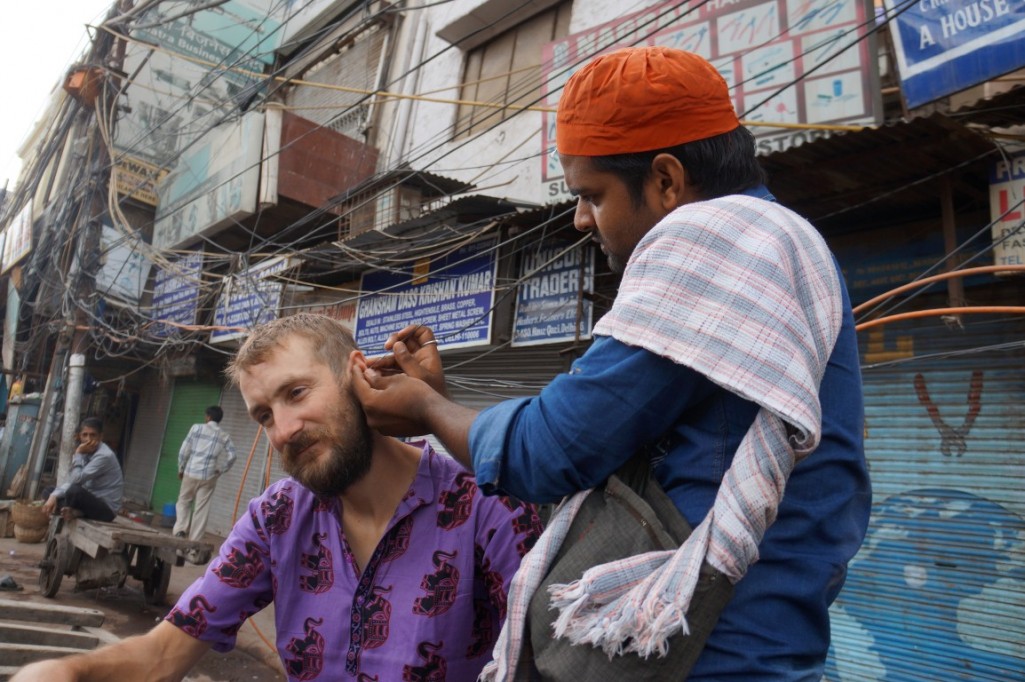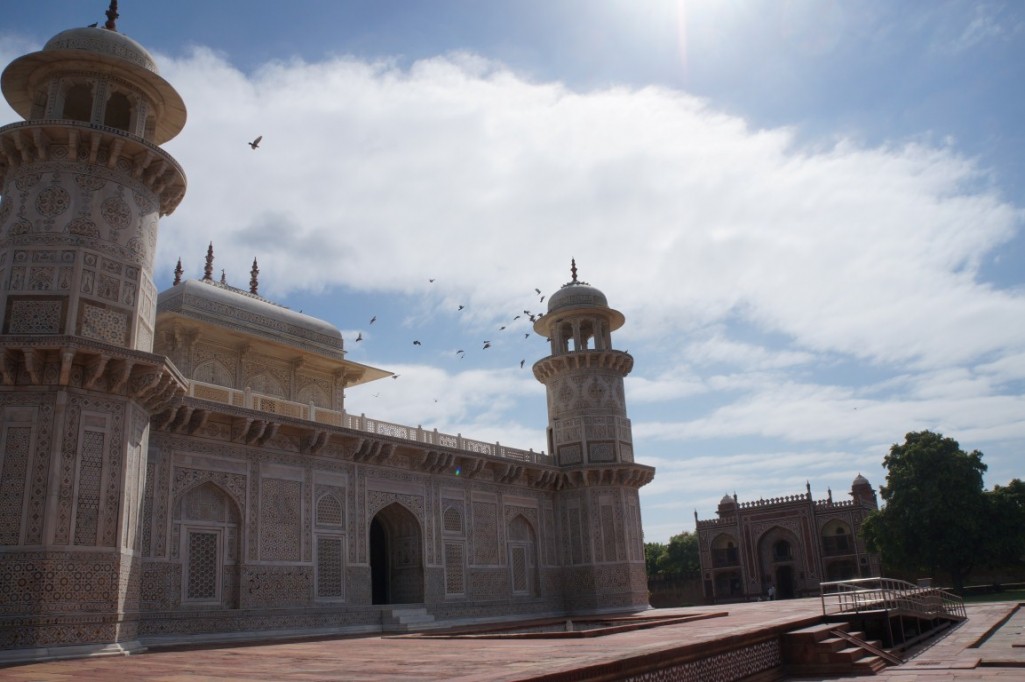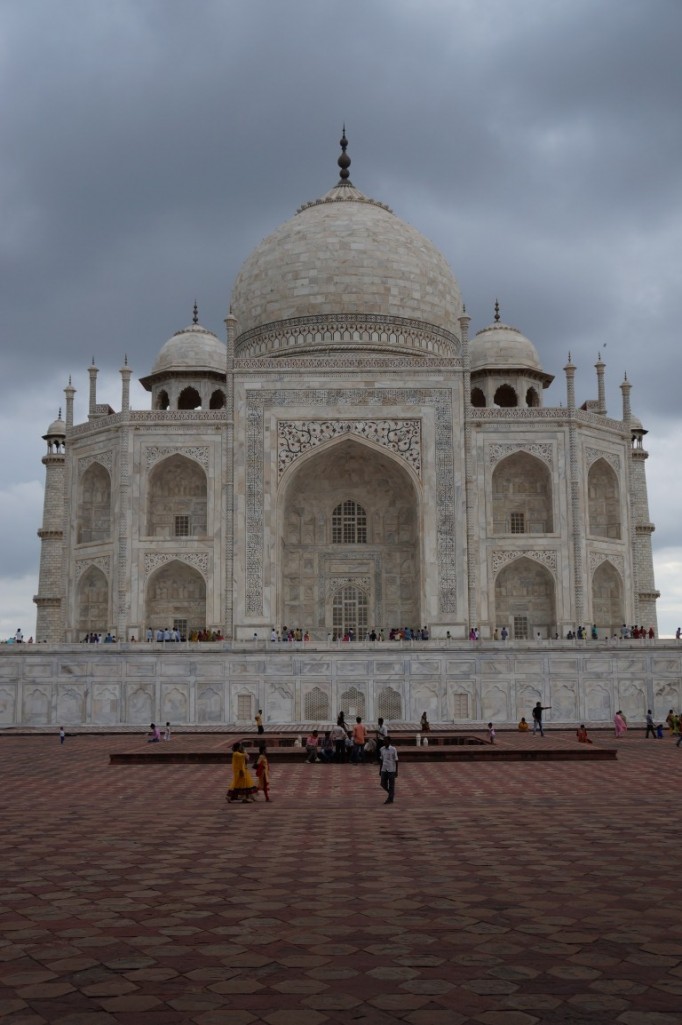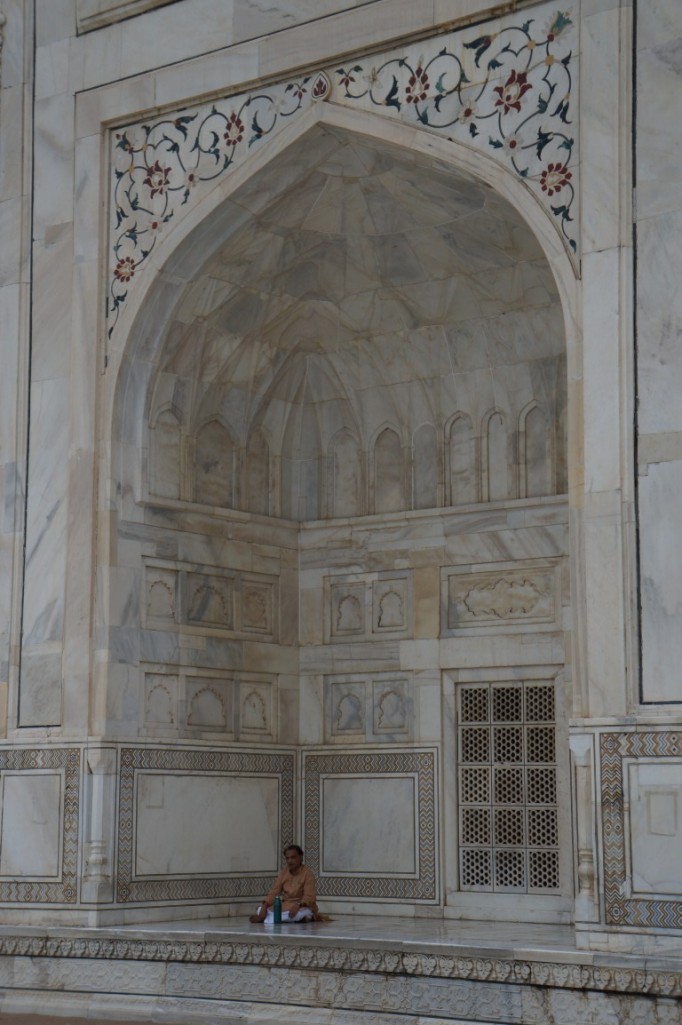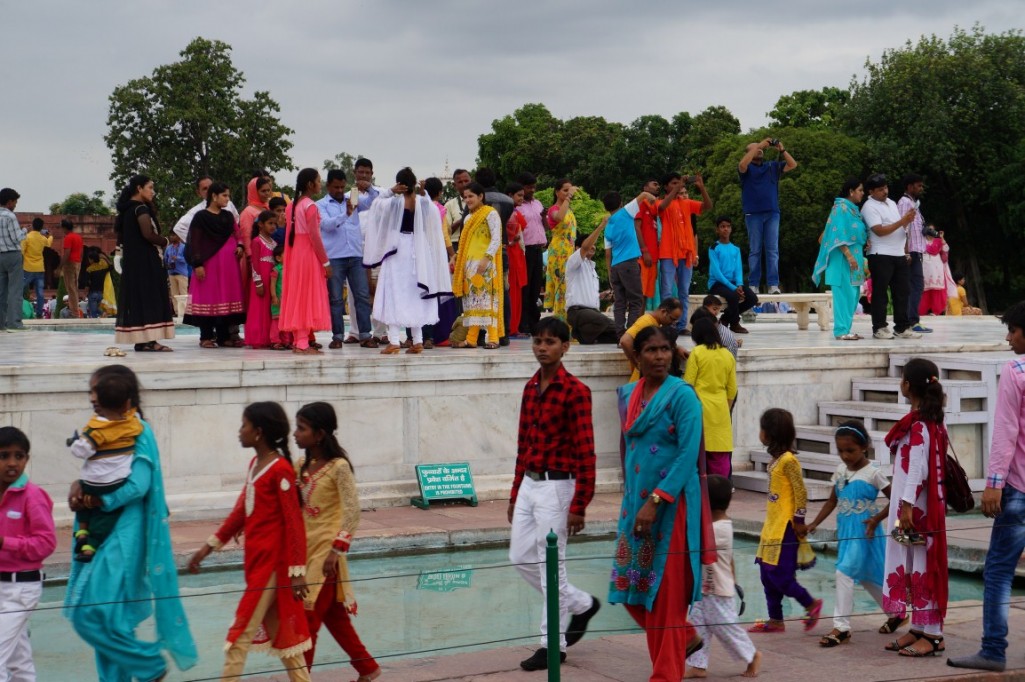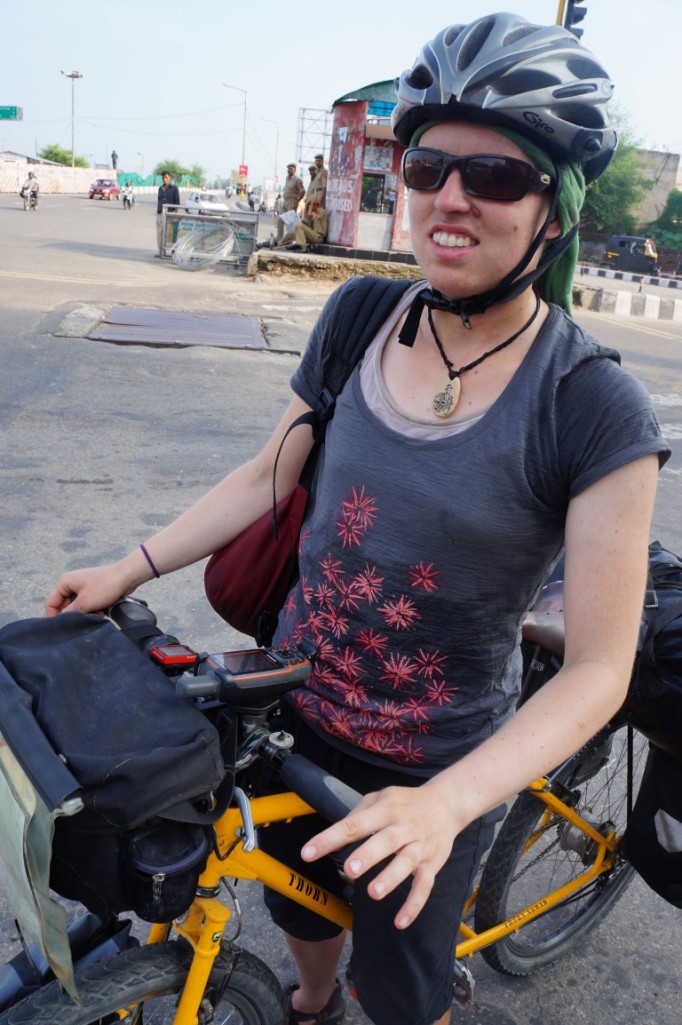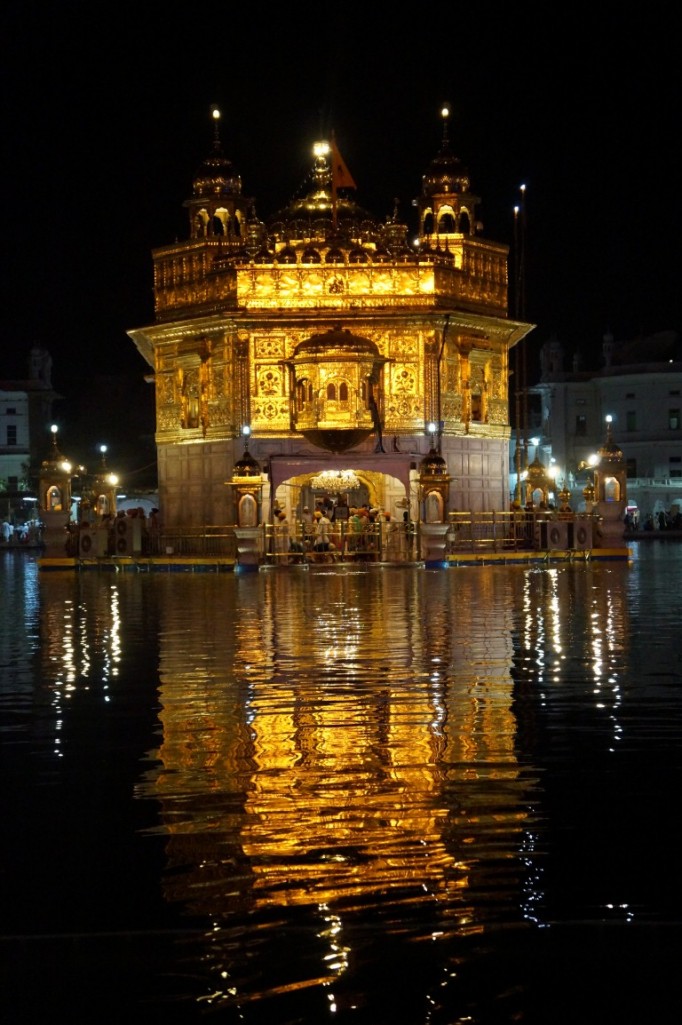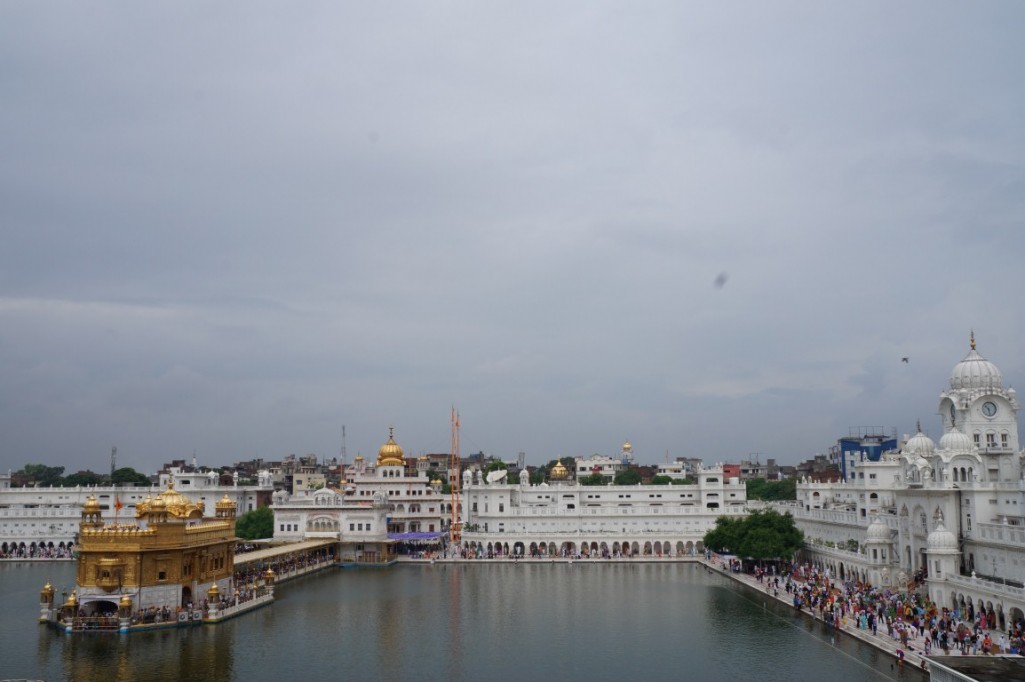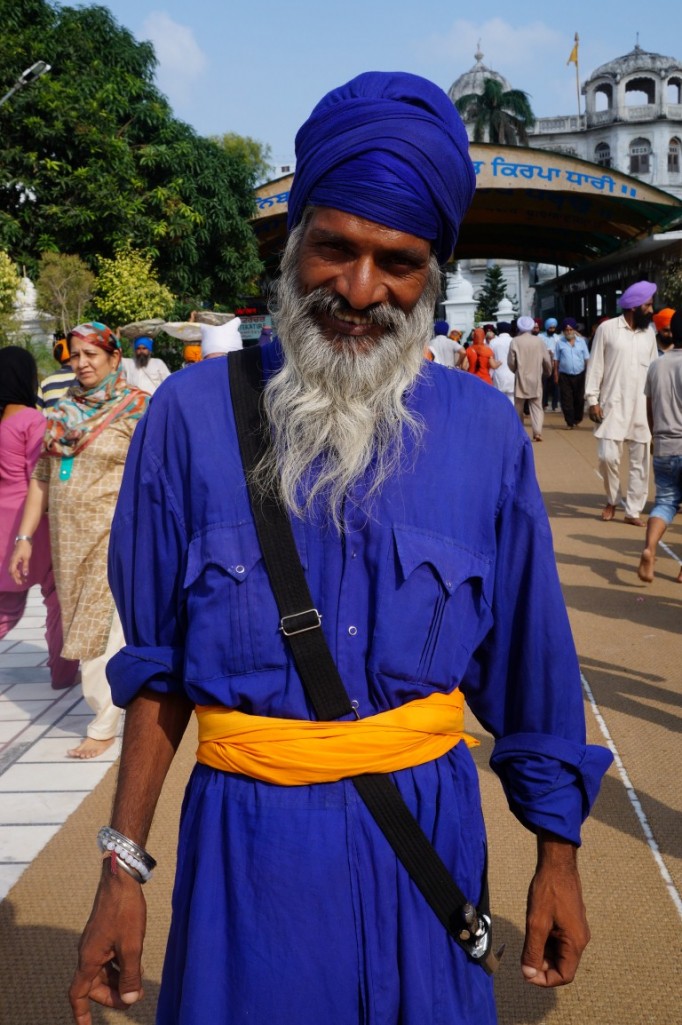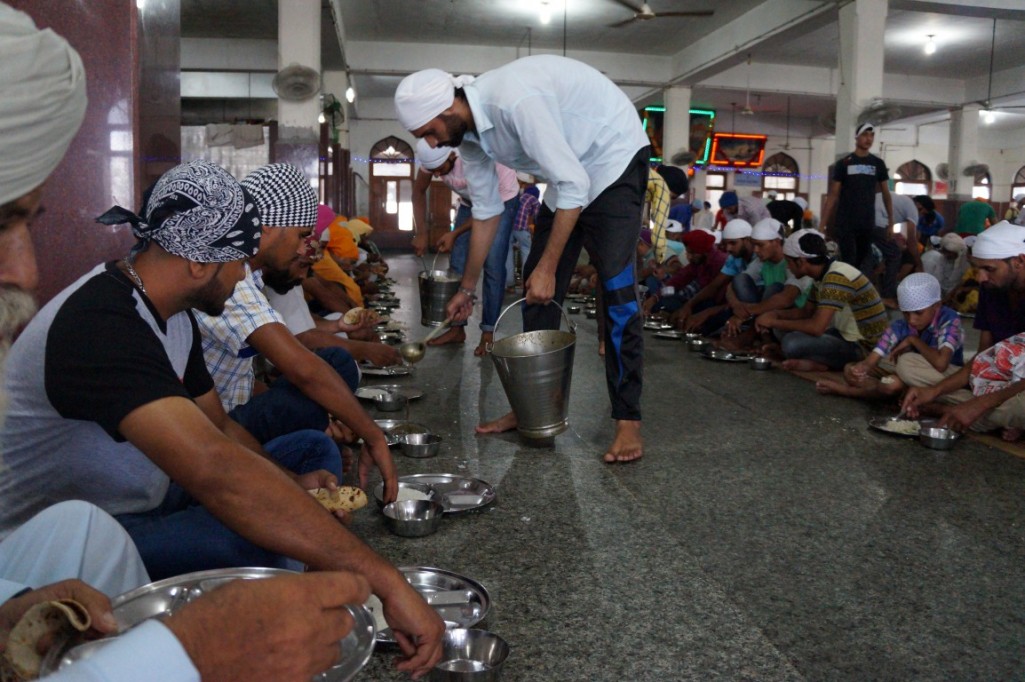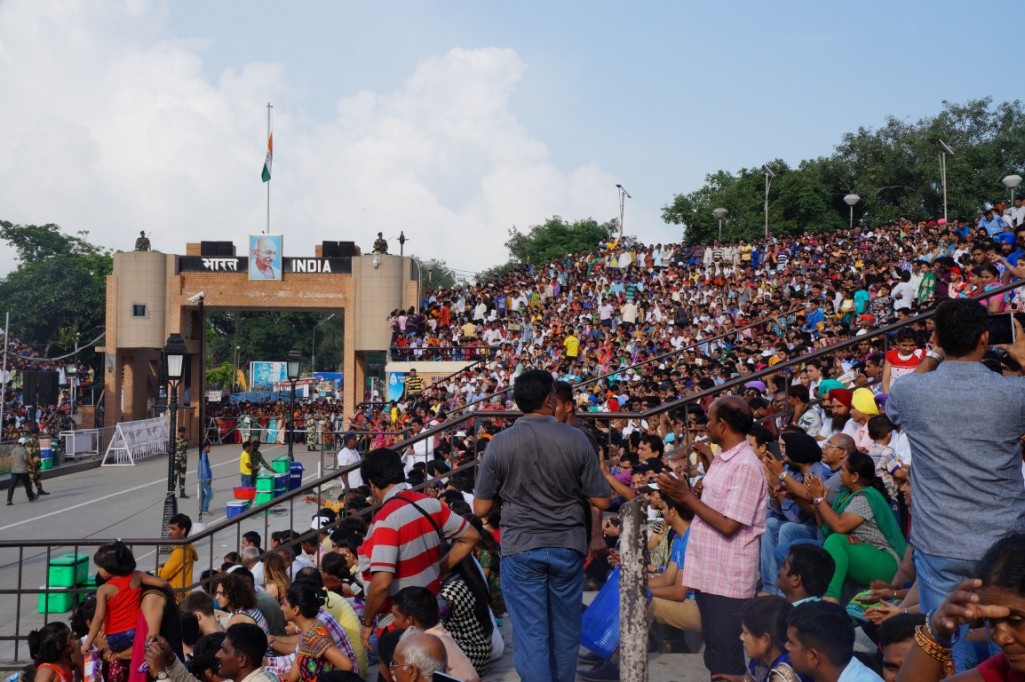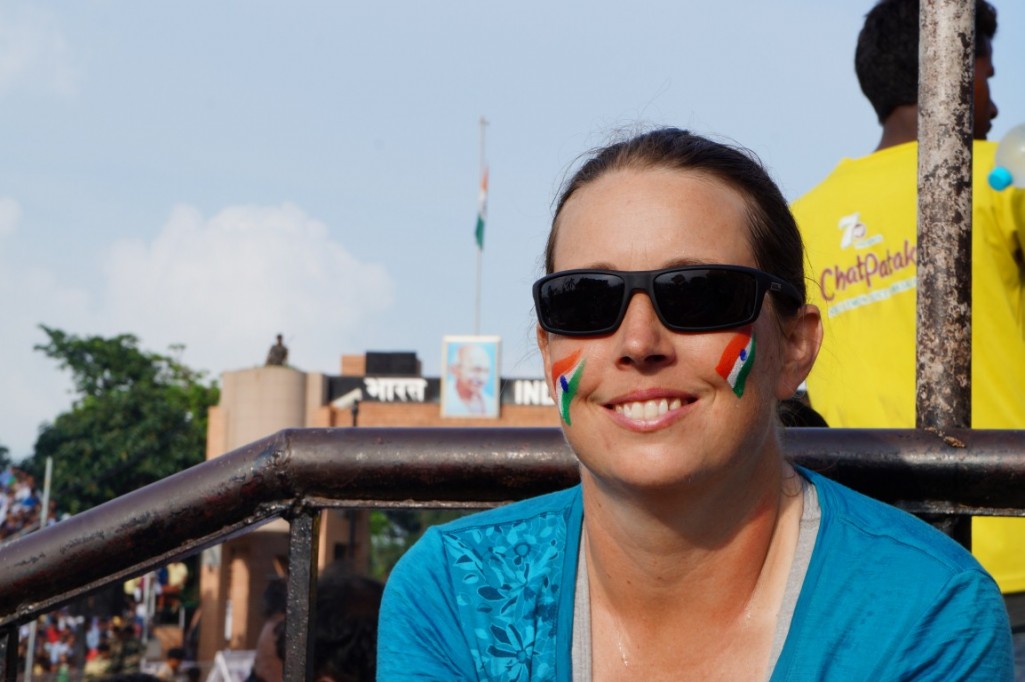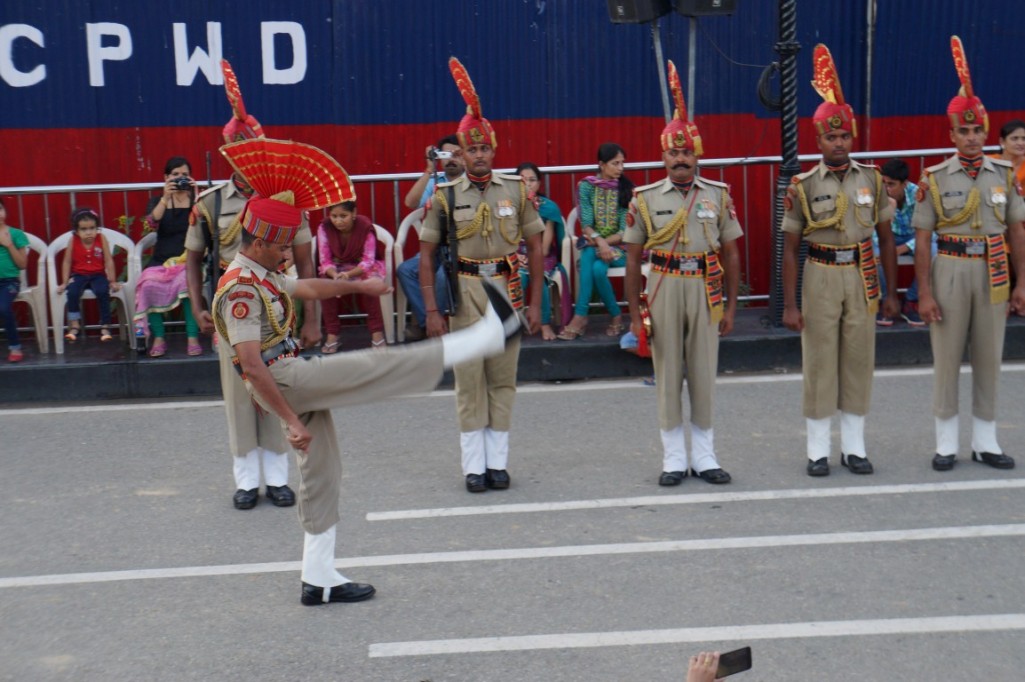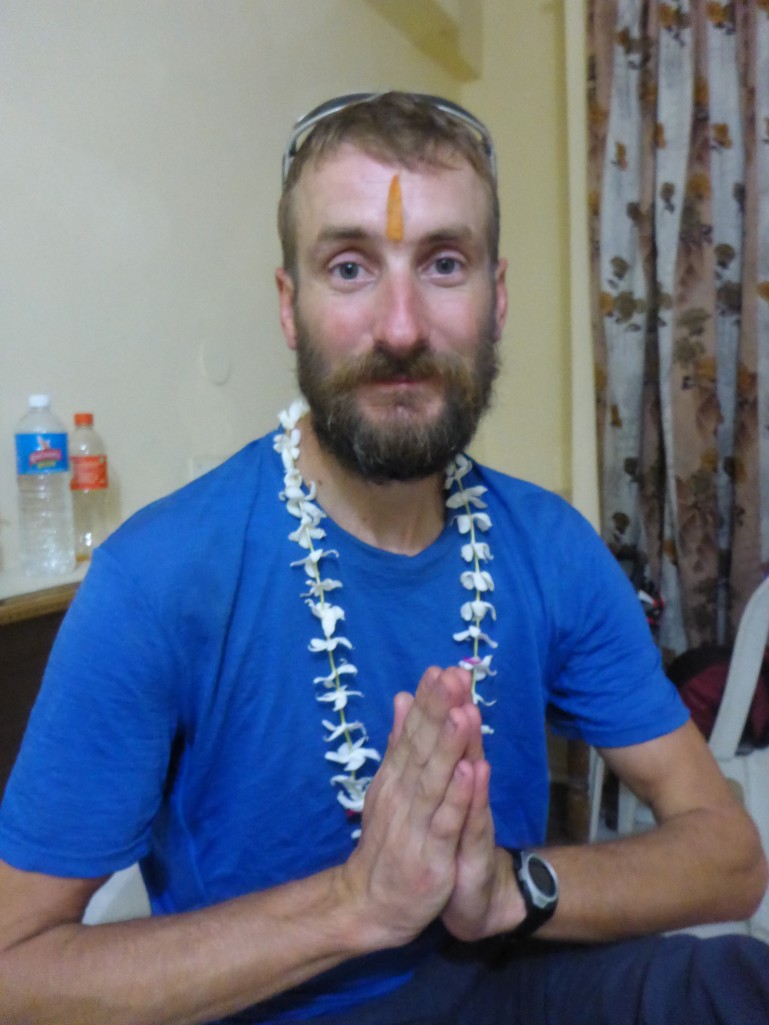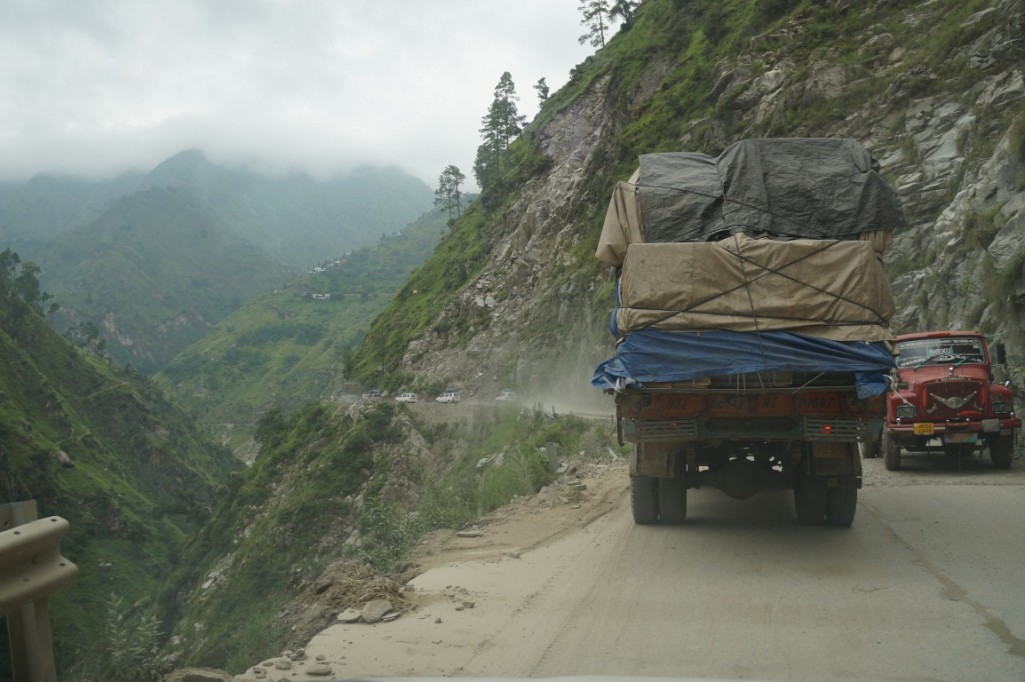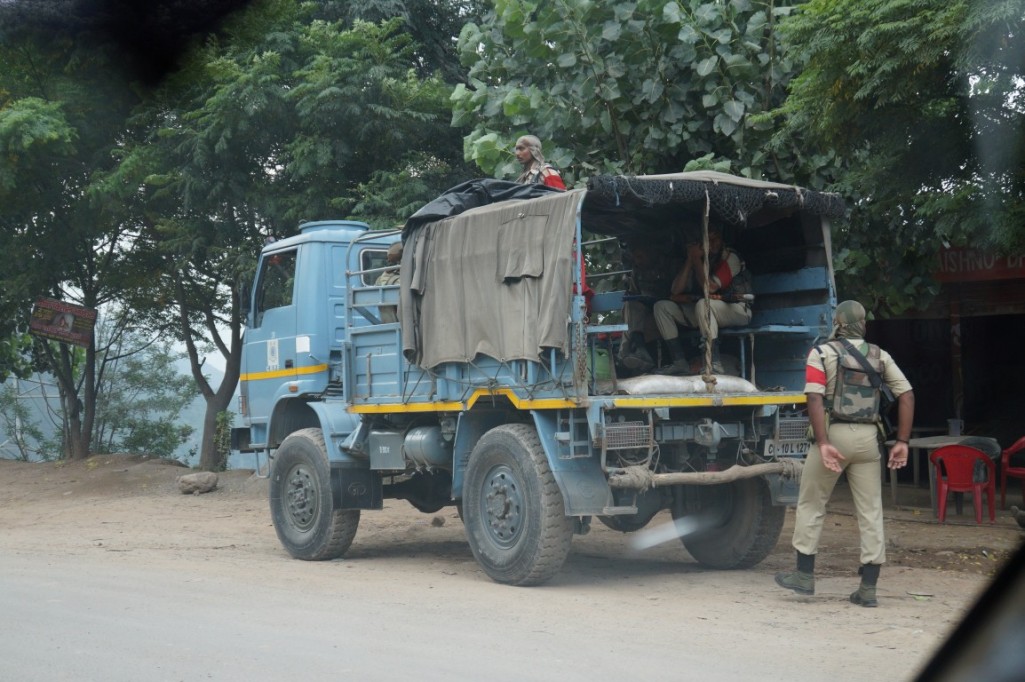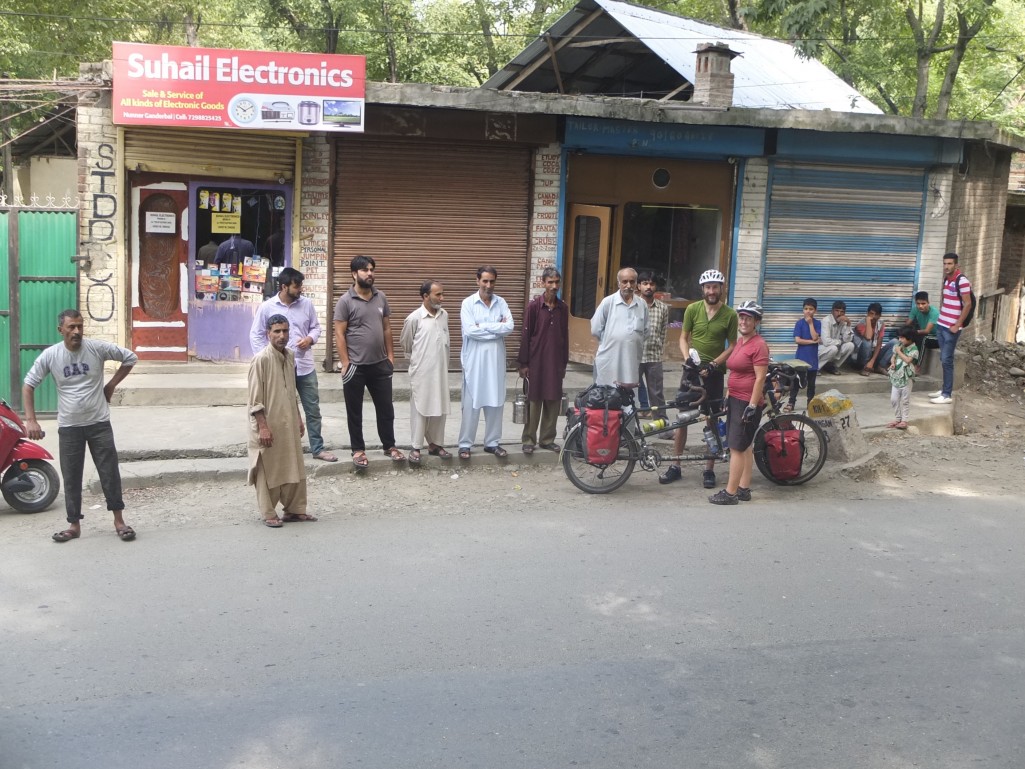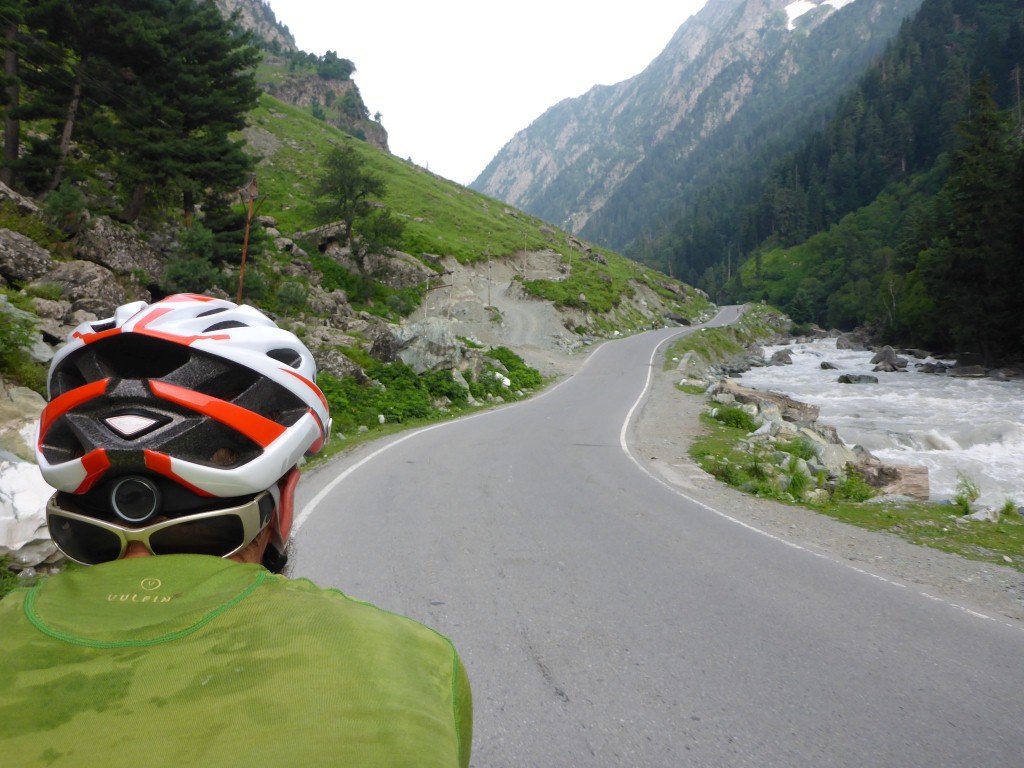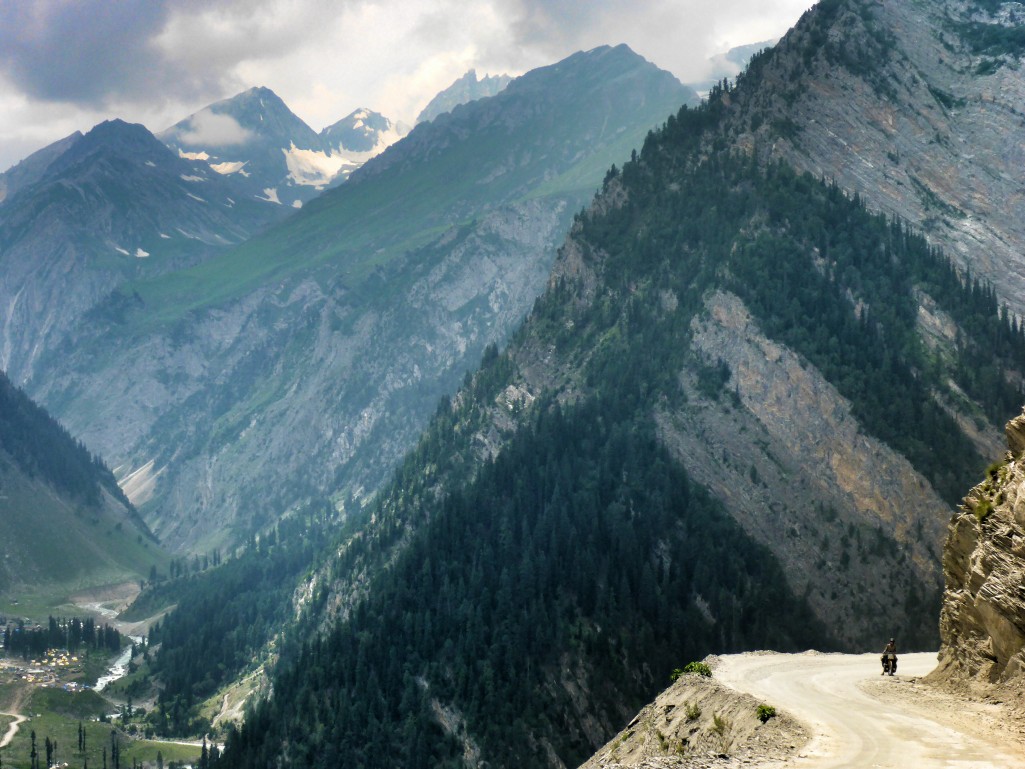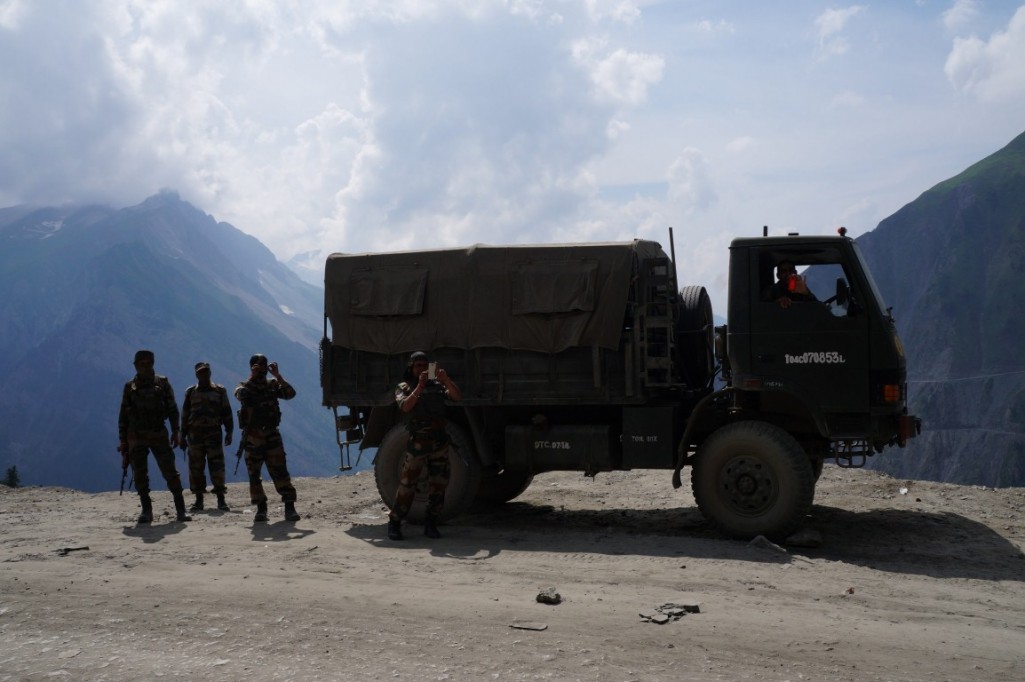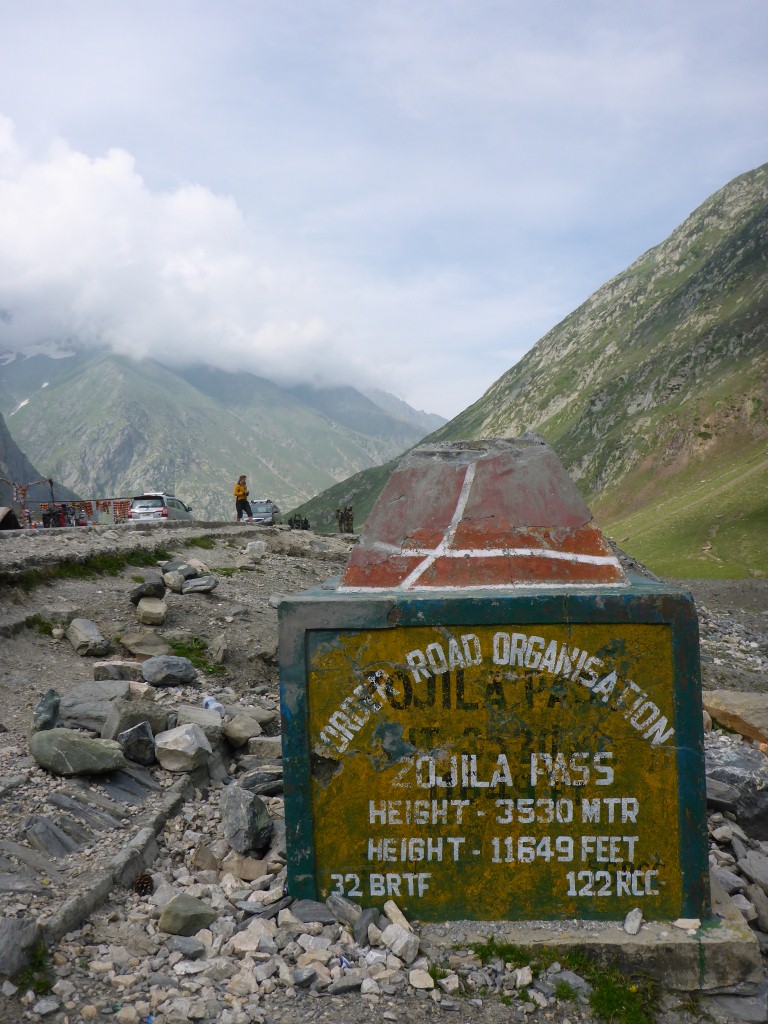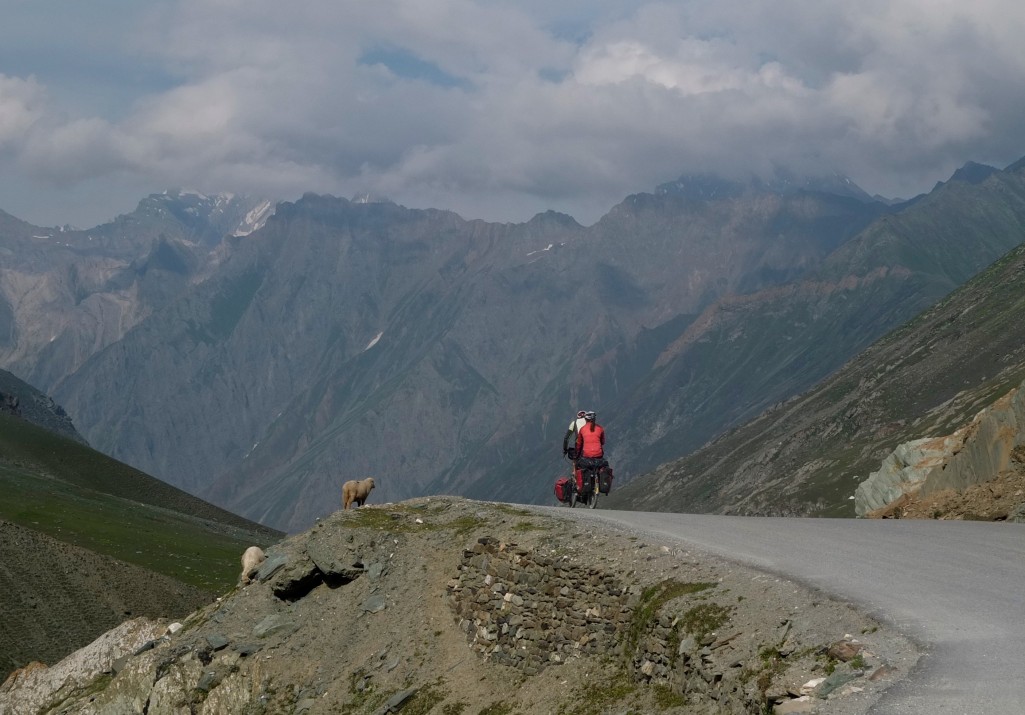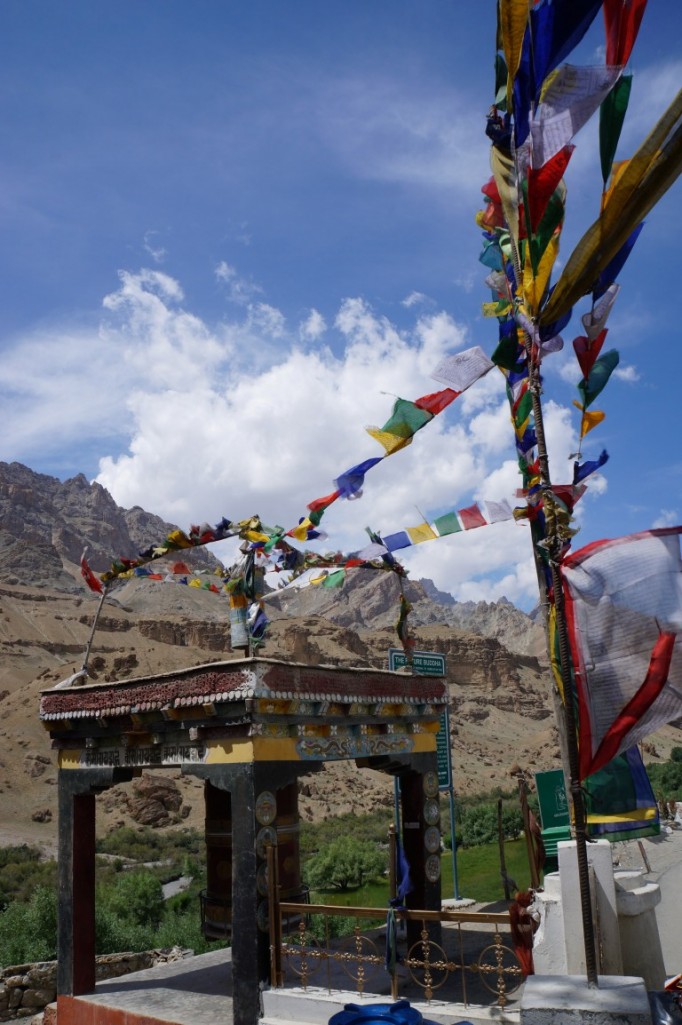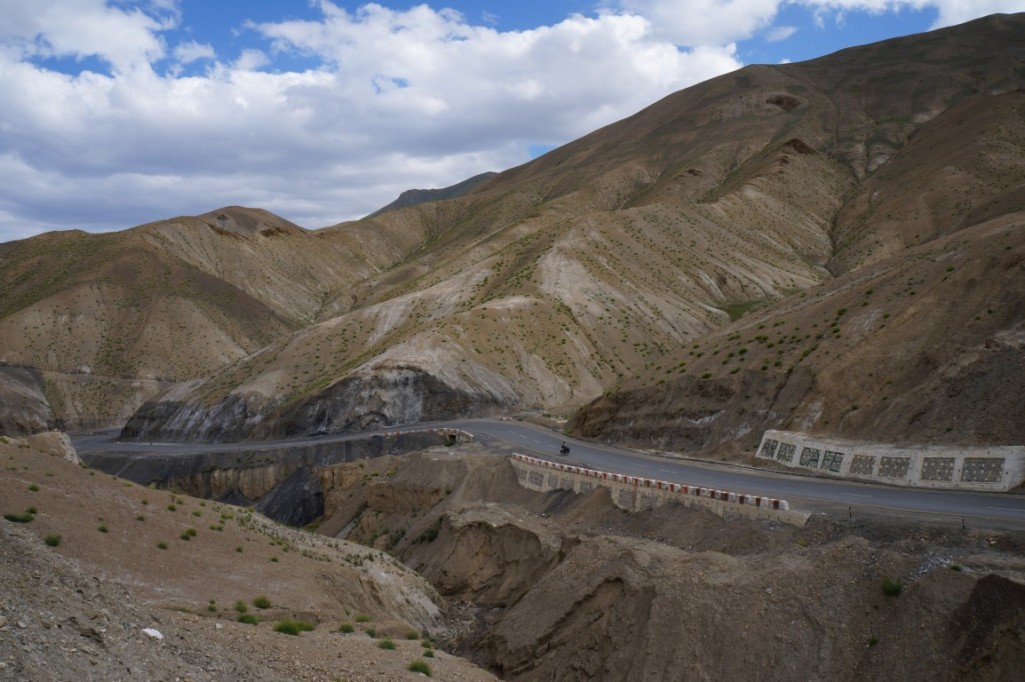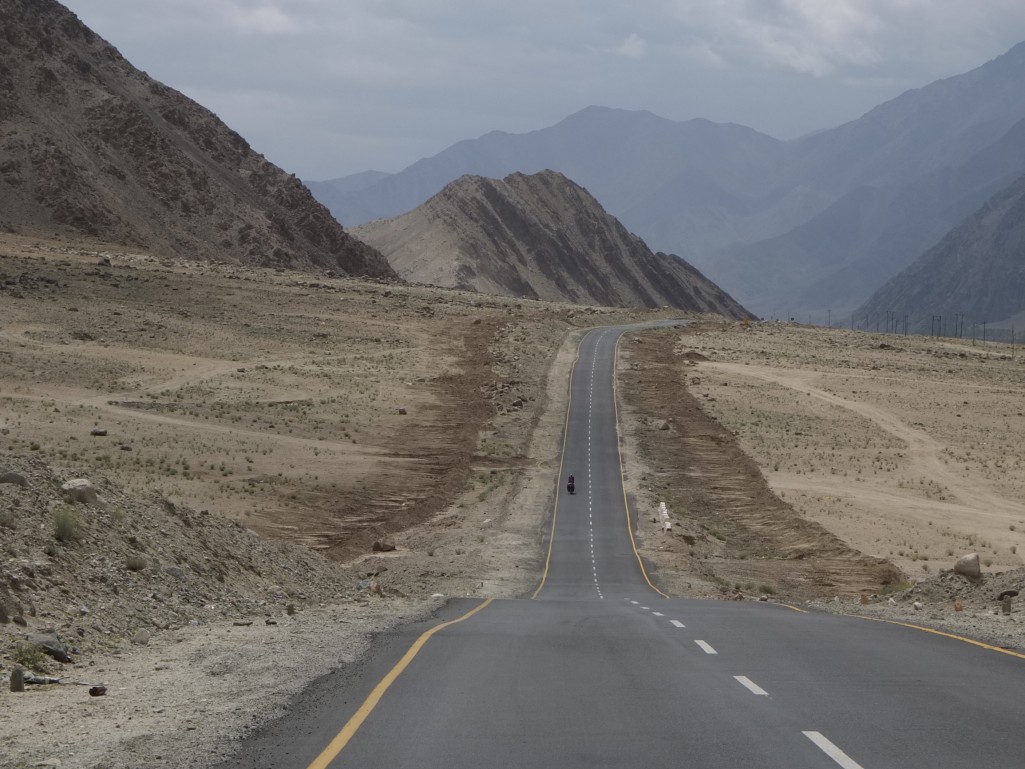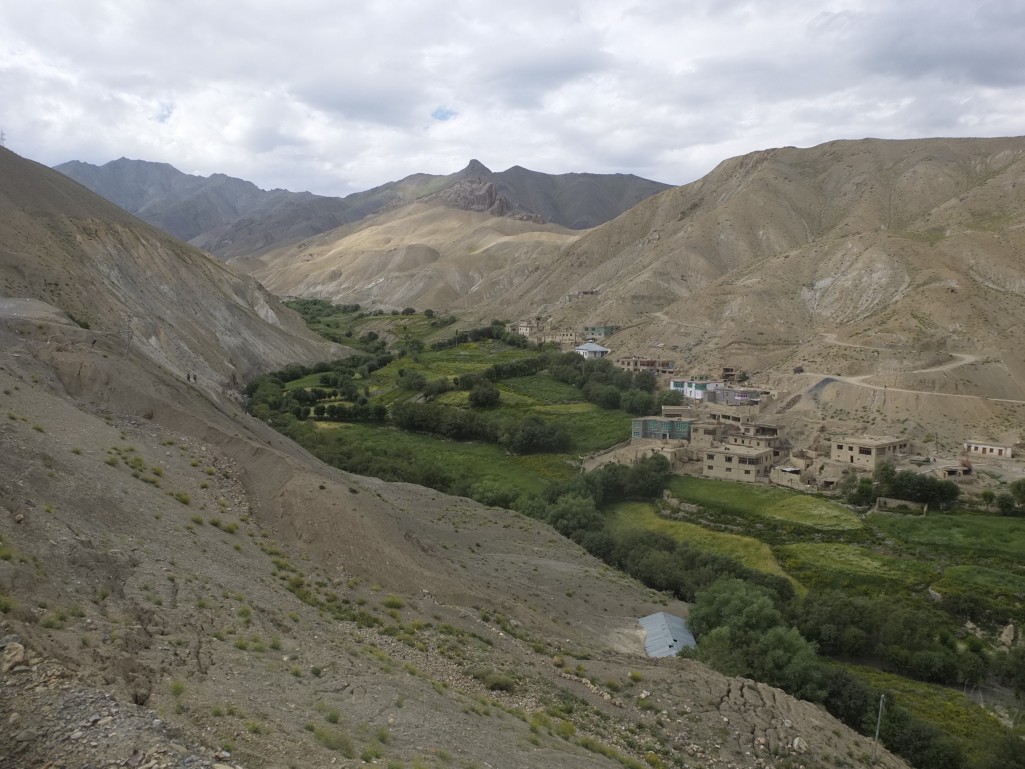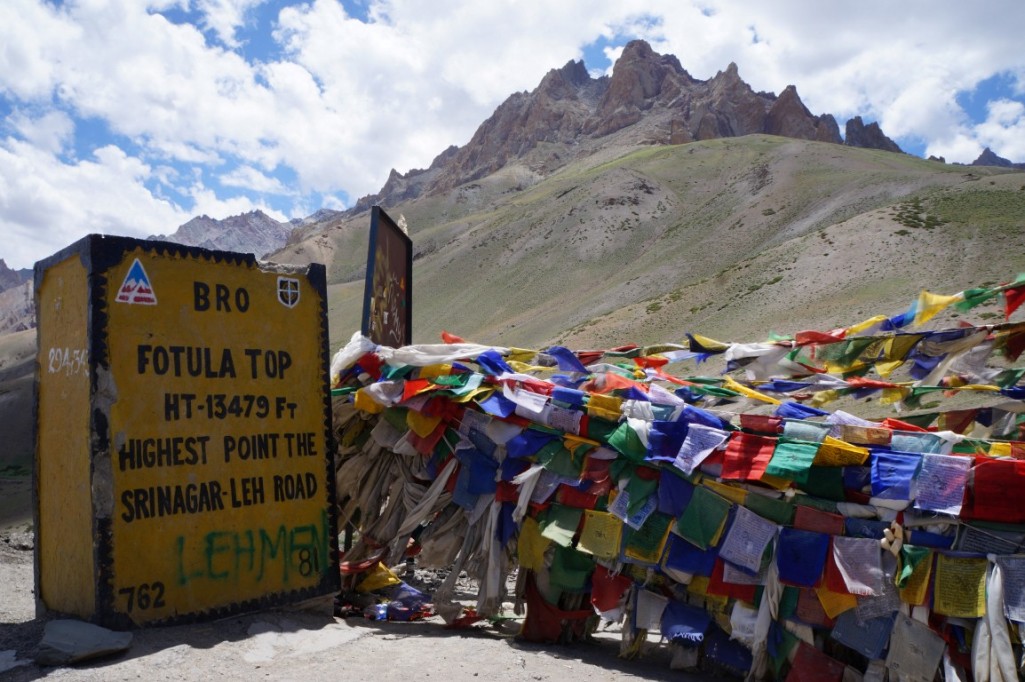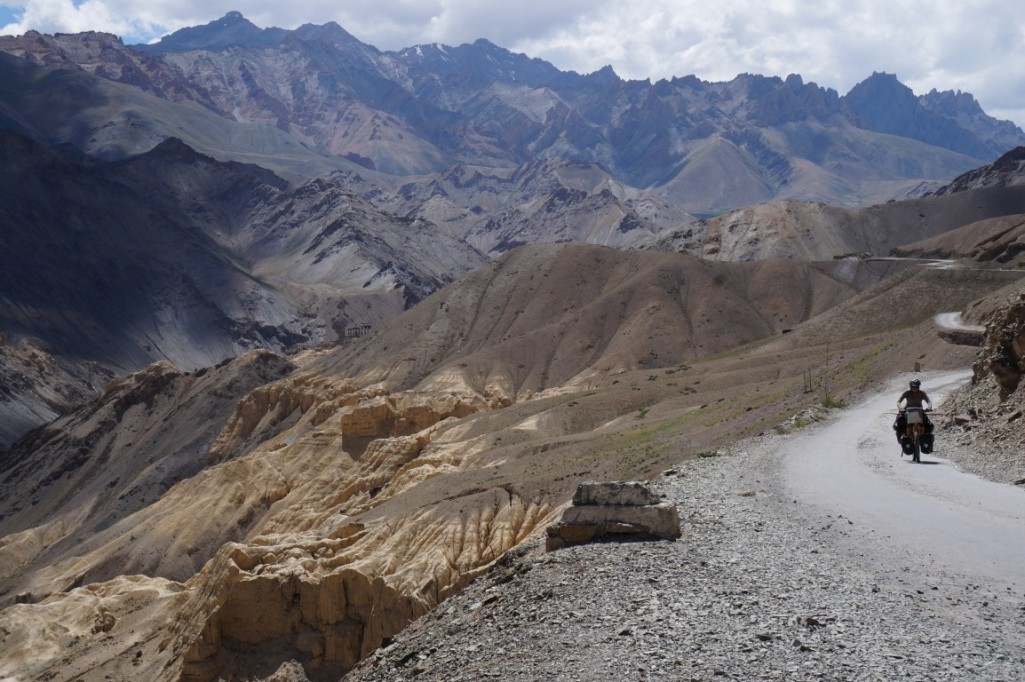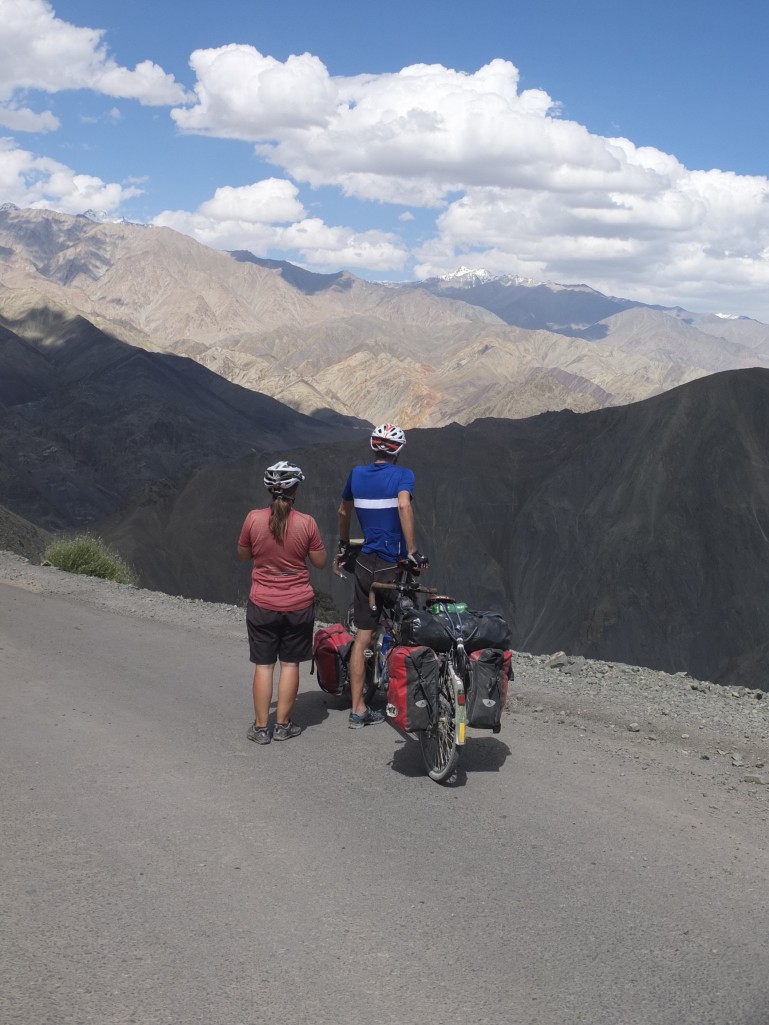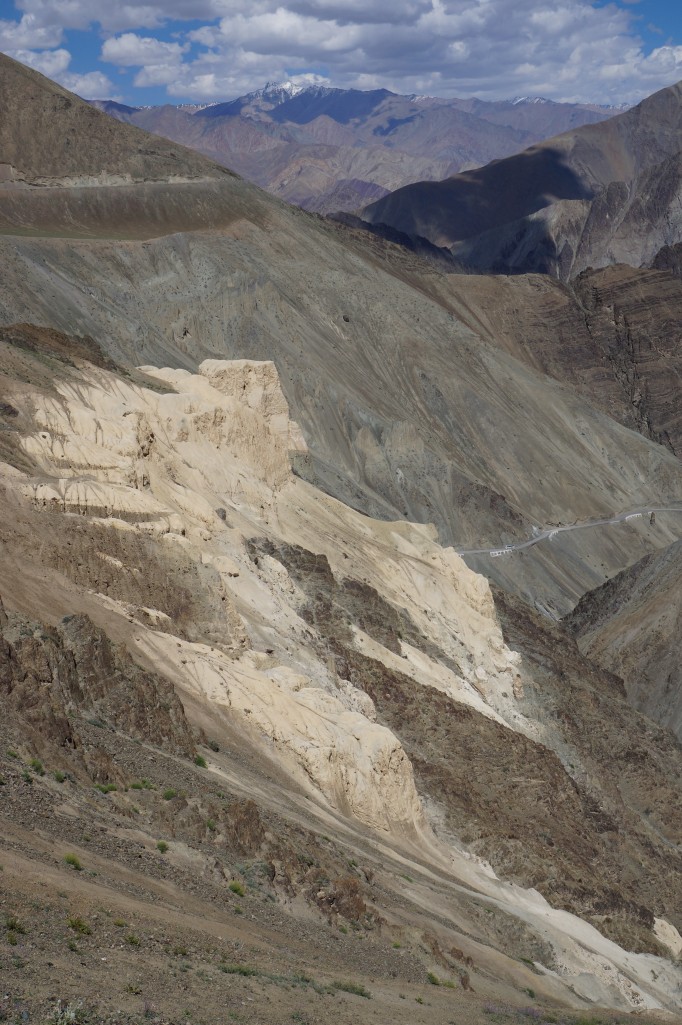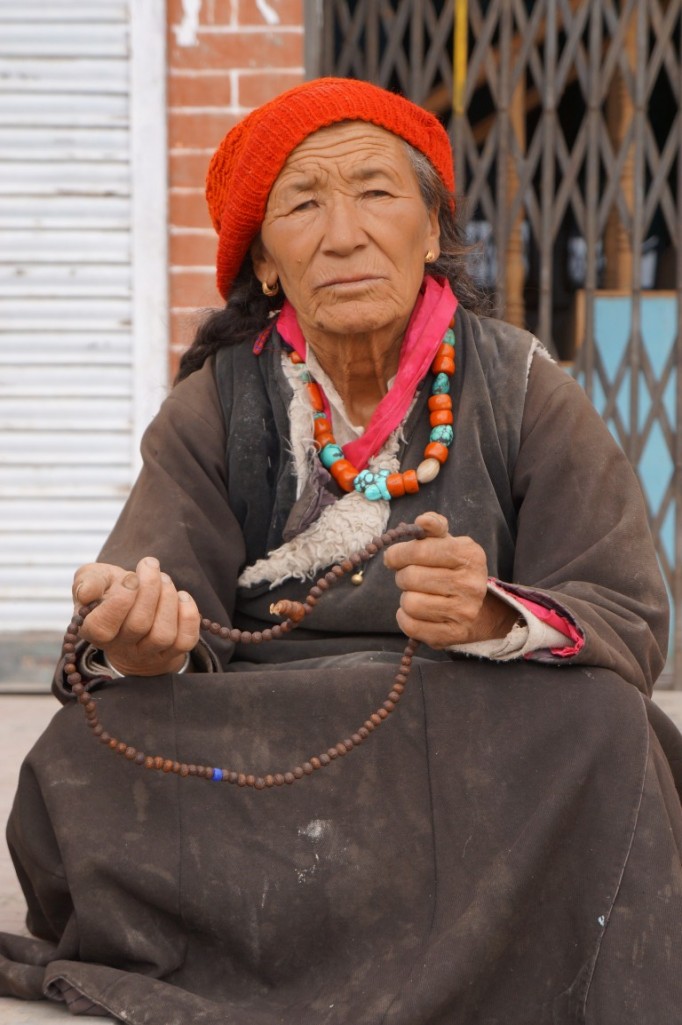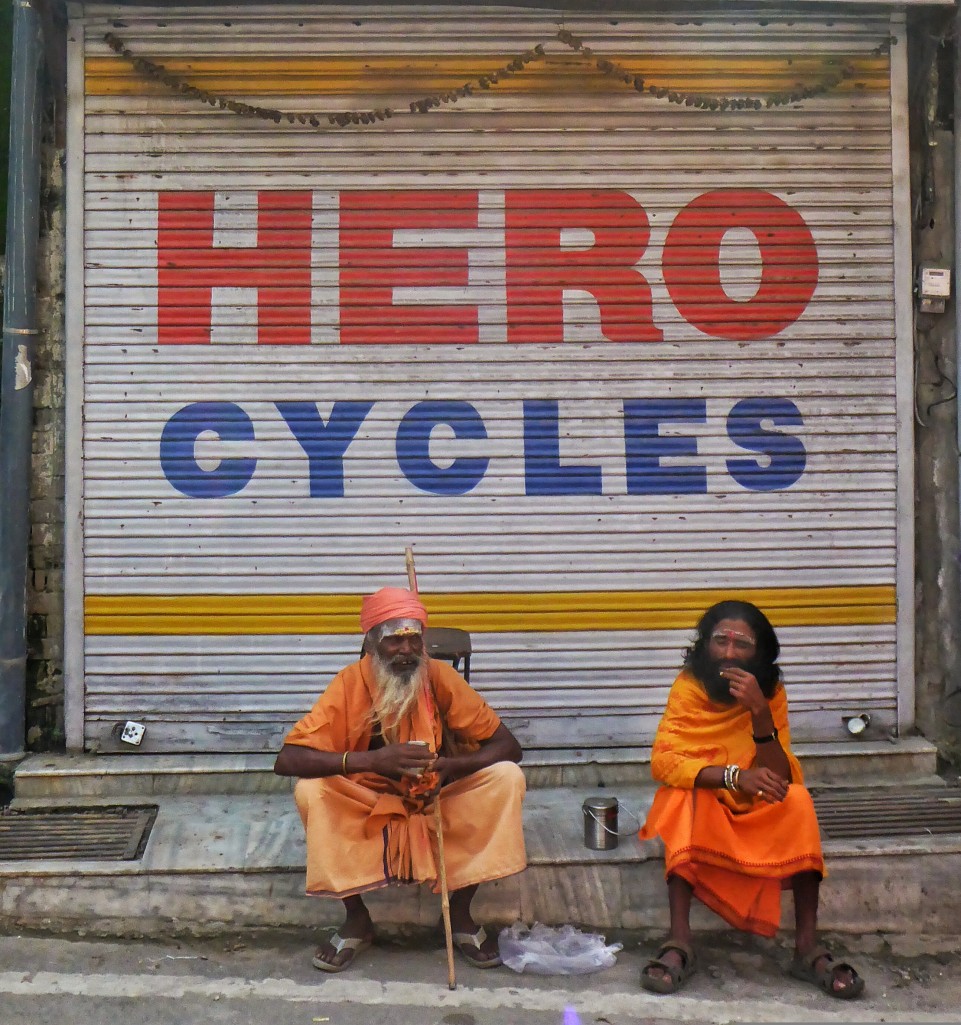Leh to Shimla

There’s always a fine line between keeping the momentum of the trip going to seek out the next chapter of the adventure and knowing when it’s time to stop and rest. Kirsty will tell you that I have no idea where this line is drawn, and she’s probably right.
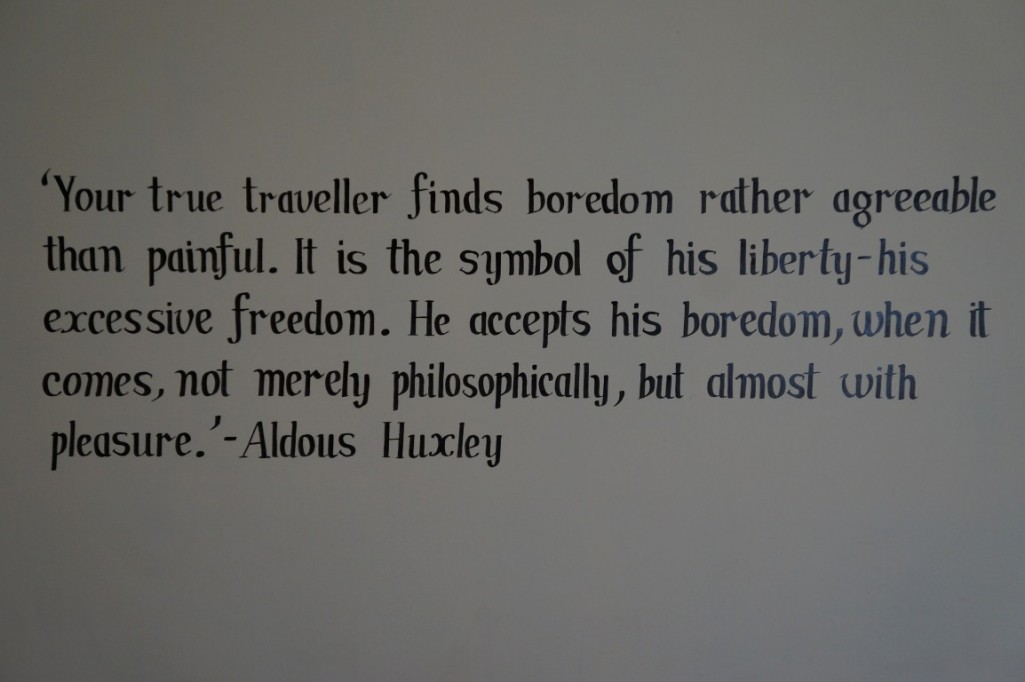
15th August – 16th September 2015
We return to the saddles on a bright, sunny afternoon, leaving Leh to take on the ‘highway’ towards Menali. This is another road of some infamy amongst touring cyclists with the promise of high passes, challenging road conditions but the reward of some of the finest scenery the Indian Himalaya has to offer. It was only cleared of snow in early July and will be closed by late October once winter takes hold again.
Our welcome travelling companion Tara is still with us but less welcome are the stomach bugs that refuse to stay away. The rest, food and cocktail of tablets don’t seem to have shifted them completely but with blind hope that they are receding we carry on.

We keep the next two days short, with a visit to the huge Thiksey Monastery on the way to Upshi then camping in a field at Lato. Upshi is an appropriate name as from here the road begins going skywards and continues to do so for 60km. Stopping at Lato helps break the workload up.



As a team we’re all faltering with unexpected altitude headaches (we’re at 4000m), sore knees, sickness and general weariness . One rest day is followed by another when we wake up to heavy and cold rain which would make the rest of the climb unpleasant at best, but more likely very dangerous. While warming up in the nearby guest house we meet a variety of other two wheeled travelers.
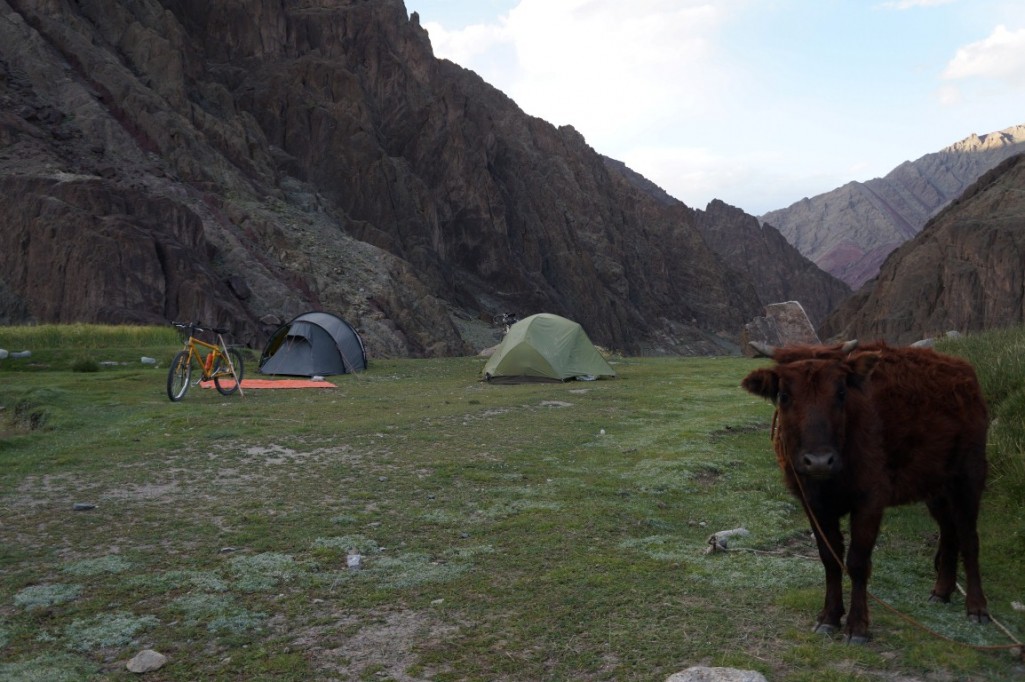
Firstly, one half of a Scottish tandem crew (http://www.peggytandem.com), Linda was glad of some company while her husband Jimmy was lying ill next door, another victim to the Indian levels of hygiene. Tandems on this road are incredibly rare so to have two in one place must be a first! Their world tour was prompted by their children having backpacking adventures making them think “Why don’t we do something like that?”.

We also have an unexpected flying visit from Sergi, the Russian we’d met in Dras. Although it’s now midday, the sun has come out and he’s pushing on to the top of the hill having started in Leh that morning. Fast and light still looking to be the sensible option but it’ll still be hard going to make it before dusk.

Two Polish cyclists then arrive. They used to be backpackers but decided to buy second hand bikes in Delhi and headed for the mountains. Cutting your teeth as a cycle tourist on the Leh Menali highway can only be described as incredibly bold but they are coping well and have made quick progress. Their $70 bikes and panniers made from converted school backpacks show that a lack of expensive equipment shouldn’t be a barrier to just getting on with the journey.

After three nights in Lato we wake to sunshine and clear heads so continue on. The road is smooth and steady and up we go. Passing 4500m the speed drops to a crawl but it’s hard to know how much of the difficulty is down to the lack of oxygen and how much is the sickness. Most likely a nasty combination of the two and we take to stopping every 5km for a sit down and a breather.

Above 5000m and the lungs are working hard. There’s a huge snow drift alongside the road then a steep rough section pushes us to the absolute limit. Cycling up here is challenging enough but we also witness a few superhuman runners taking on the La Ultra Marathon. For endurance athletes there’s always something bigger, longer, higher, more difficult but this 330km epic must be hard to beat, let alone complete.

One of the support drivers for the race, Danny is wild with enthusiasm when he sees us inching up the hill and calls for us to stop. He loads us up with Snickers, energy drink, cheese spread and biscuits but we’re too exhausted to show our true level of appreciation.
We turn through one final hairpin and get a view of the stupa and flags that must surely mark the summit. It’s as much as we can do to pedal the last 200m then we’re at the top. We’ve arrived at the Tanglang La which sits at 5328m and a sign proclaims it as the 2nd highest paved road in the world.
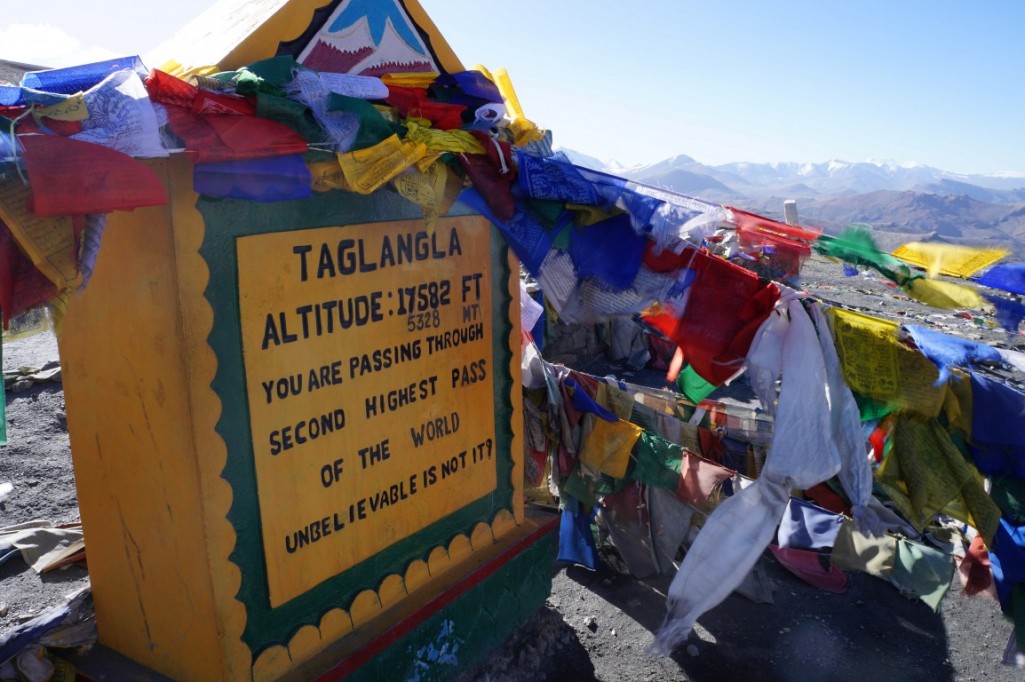
The highest is still claimed to be the Kardang La, north of Leh who’s summit sign show it as 5602m. In reality, modern GPS has shown that it’s only 5359m and there are several higher roads in India and Tibet. This doesn’t stop thousands of t-shirts being sold to motorbikers who have ridden to the top to claim their ‘highest road conquered’ accolade.

We’re breathless, dizzy and weak-legged so after stumbling around to take a few photos we wearily swing back onto the bikes and try to get down the mountain again. A rough unpaved road slows down our progress so once it levels off as we arrive at the small encampment of Debring it’s already time for dinner and sleep.

Because this stretch of the road is closed for 8-9 months of the year, the settlements along it are only temporary. They mainly consist of parachute tents housing dhabas that offer basic food and shelter for travellers and truckers. Once the snow starts falling these will all be packed up and shipped out until next summer. The food, music and hospitality are all largely Tibetan while the language is now Ladaki, so we say ‘Julay’ for hello instead of the ‘Salam’ of Urdu speaking Kashmir or ‘Namaste’ for southern Hindu regions. English is still spoken as a common language, after Hindi for all of India though, and we can usually find someone who can just about understand us.
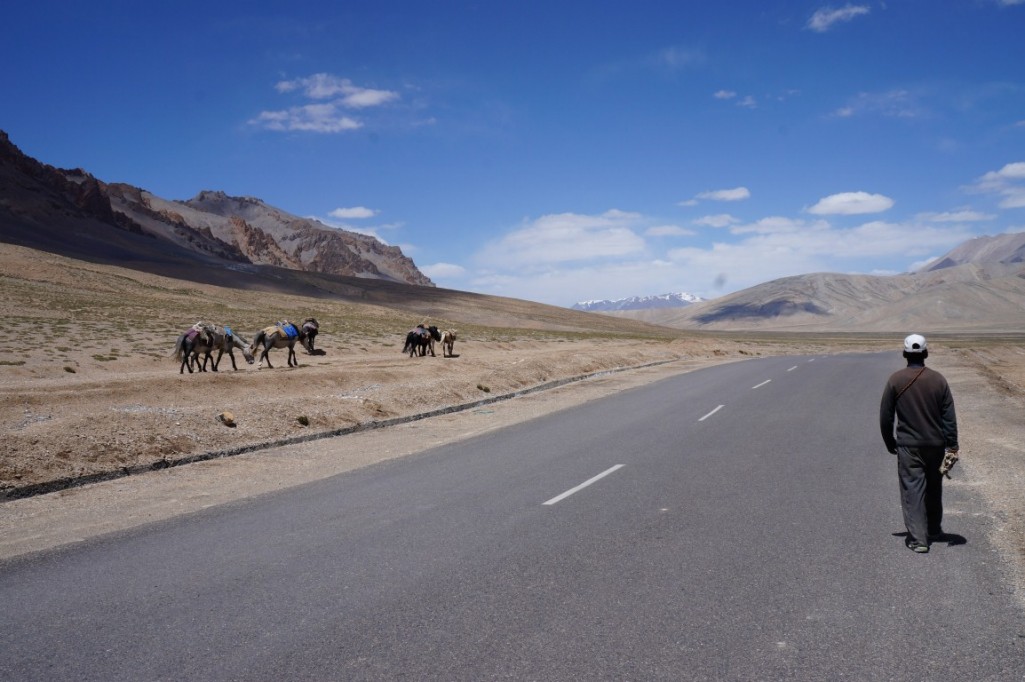
After breaking camp by a mirror smooth lake we’re out into the Morei Plains, a high altitude desert that’s a welcome relief after yesterday’s climb and reminiscent of some of the scenery on the Pamir Highway.
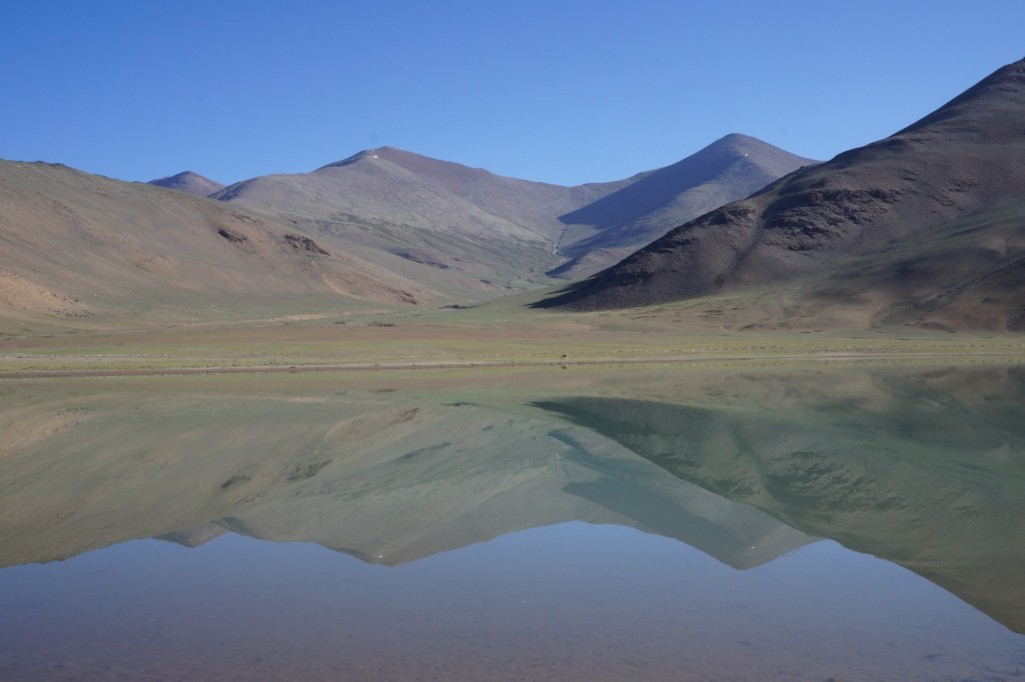

Pang is another temporary village of tents and stone shelters alongside the claimed ‘Highest Army Transition Camp in the World” and a road workers’ settlement.
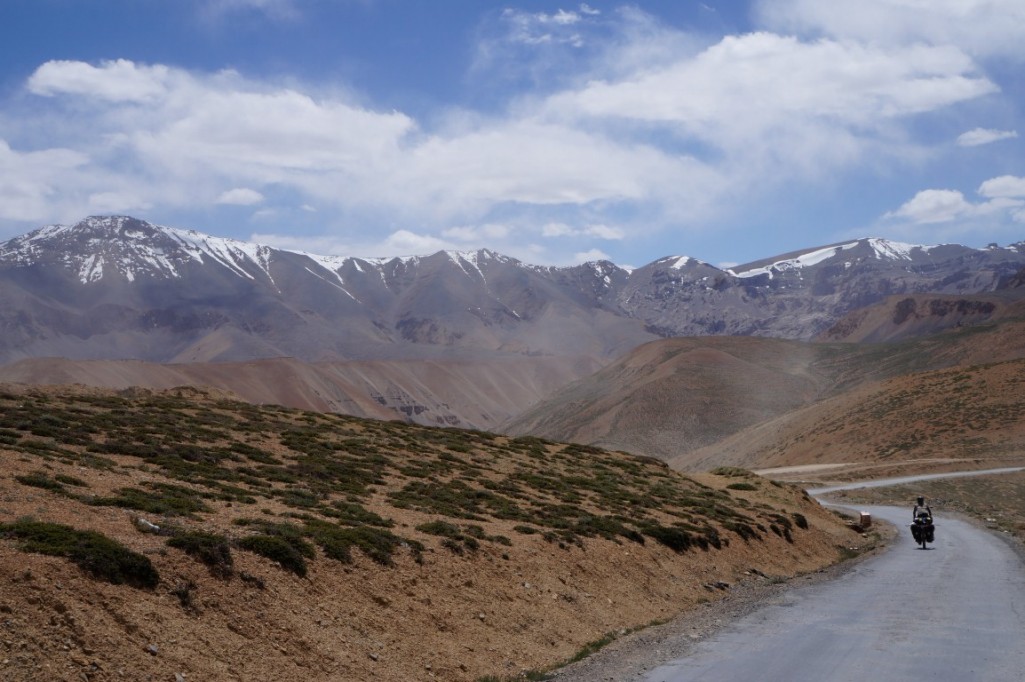
In the morning we have to push our bikes up the steep bank from the river where we had camped while 30 or so road workers stare at us and ignore my calls asking for their help. After an hour waiting for three pancakes to be made we set off for the next big climb.
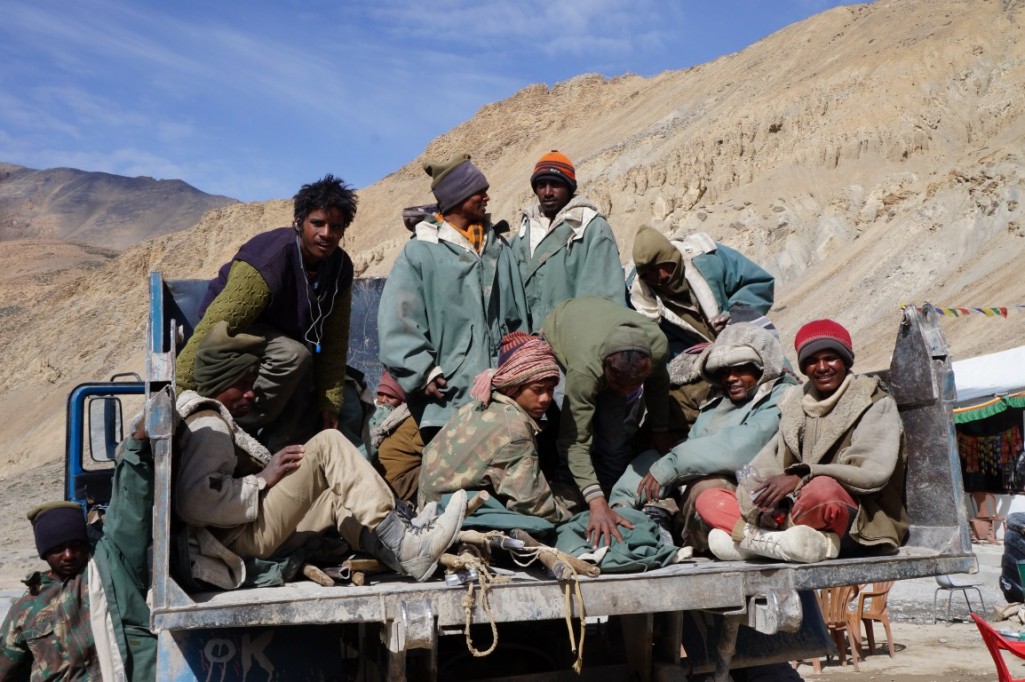
Passing through a narrow gorge we then power up a steep hairpin onto a road that is barely more than a ledge carved into the cliff face. Anyone familiar with programmes with titles like “Worlds most Dangerous Roads!” will probably have seen something like this, where the buses are cm away from tumbling over the edge. Overtaking is impossible for most of the way so some luck is required to make it round the blind corners without coming face to face with a speeding tanker.
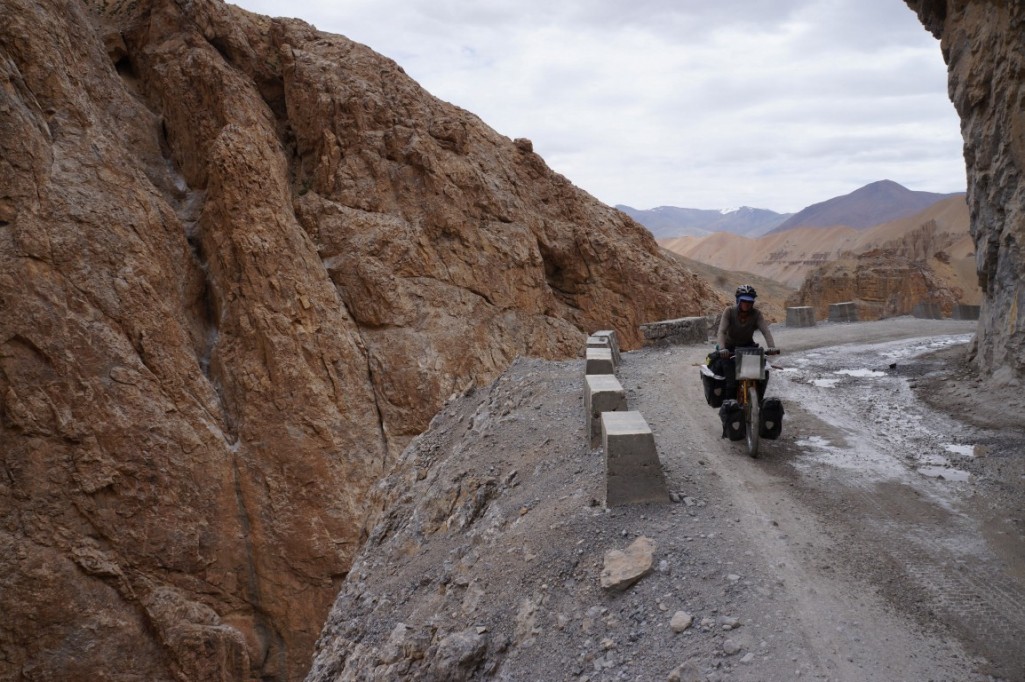


The rugged climb to the top of the 5077m Lachung La takes us 4 hours to complete but we feel much stronger than we did on the Tanglang La. Once again the body’s ability to adapt to altitude surprises us.
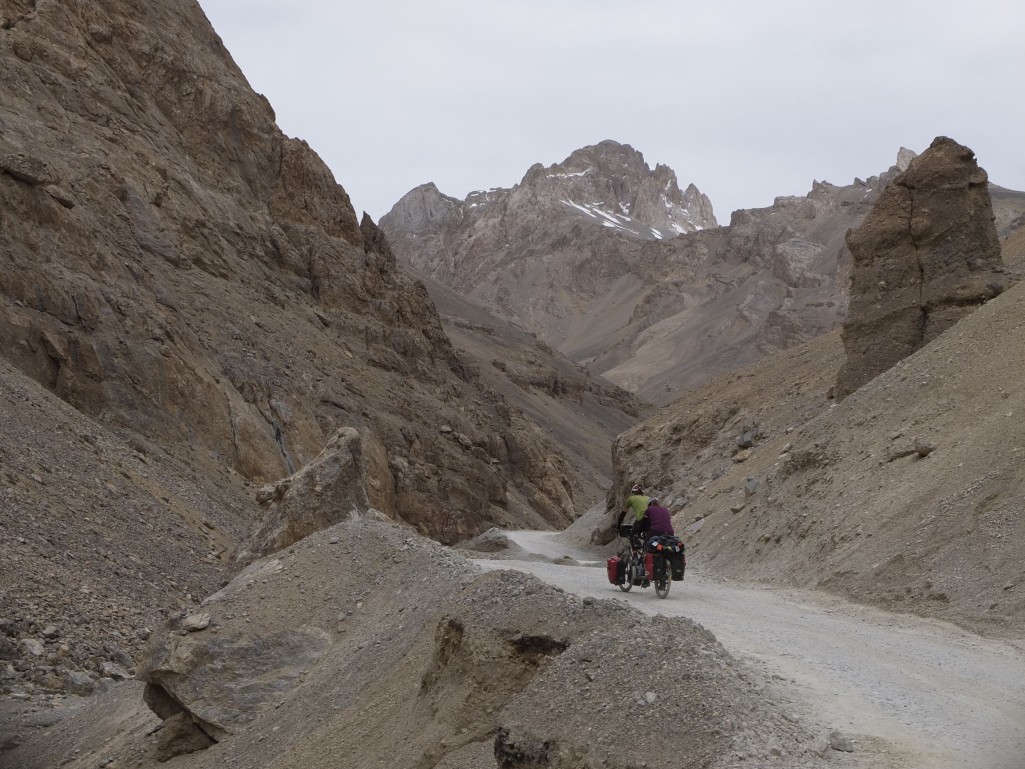
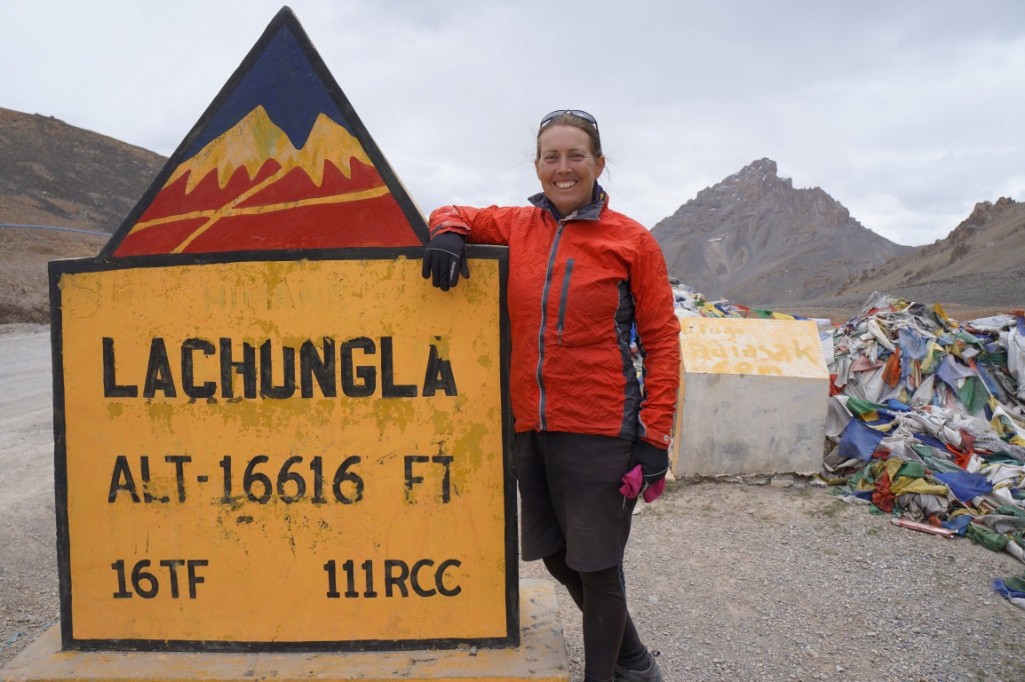
Also surprising is the magnificent view that unfolds as we roll over the top. With everything that we’ve seen so far on this trip I was afraid that some ‘scenery fatigue’ would be creeping in, preventing me from fully enjoying yet another panoramic mountain vista. But the Himalayas are as varied as they are high so each valley and each peak has it’s own characteristic and this one is very special.

From the warm reds and oranges of the Morei Plains we now have cold greys and blues topped with a permanent blanket of white snow. Below us is a vast bowl that we pick our way down into before hauling up the other side onto the modest summit of the Nakee La.

Rolling along for the next 10km it’s hard to keep my eyes on the road as the sheer drop down into the deep valley to our left is so mesmerising. Some stern words from the stoker encourage me to concentrate a bit harder on not getting too close a look and to watch the road ahead.

Then we come to the Gato Loops, 21 hairpins scribbled across the hillside like the calling card of Zorro. With the evening light now reflecting off the rocks around us it’s another wonderful moment that confirms that I’ll never have my fill of mountain scenery. We camp soon after the bottom and spend the evening drinking in our surroundings

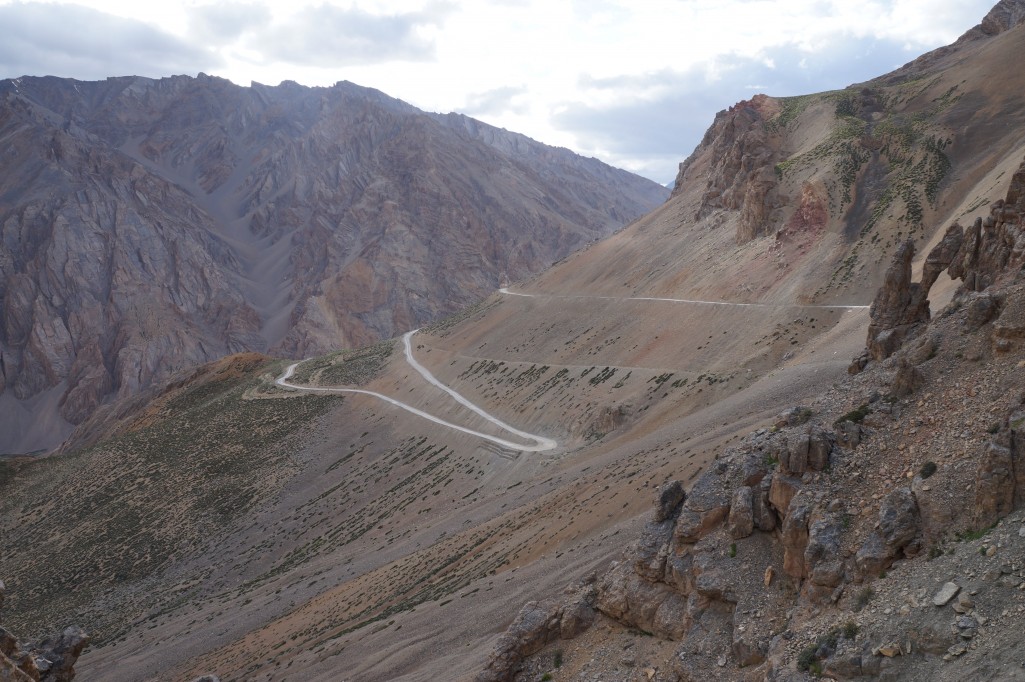




After 20km of an undulating road that follows the river valley we pass through tents and huts at Sarchu then battle a head wind in a wide valley while the road begins to edge upwards again. As things begin to get more difficult we meet a small group of supported cyclists who feed us fudge and advise us to stop there for the night as the road ahead deteriorates further. It’s an enticing prospect as there’s a small lake with a grassy ledge alongside but we haven’t got any food for dinner so have to push on.


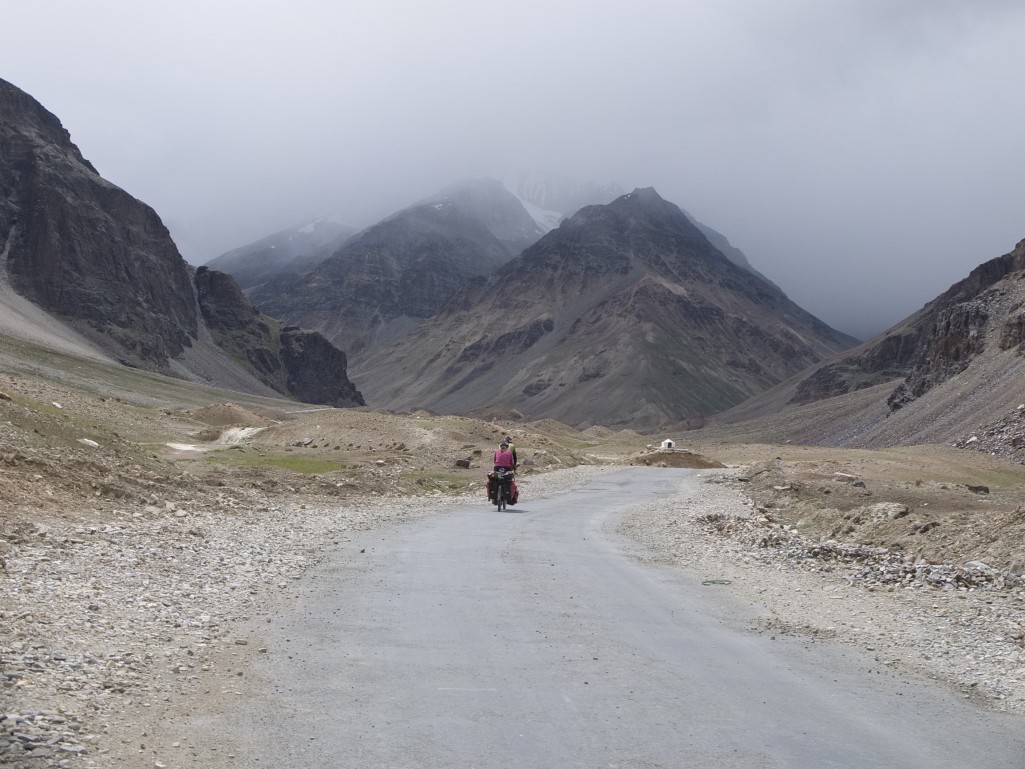
The road becomes rocky and steep with short sections that require every ounce of power from our legs to launch ourselves up and over the obstacles. We ride up small streams where the melt water is pouring down from the high peaks above us and we’re frequently passed by trucks and tankers who have just about enough room to get by without us having to stop. The tankers are ferrying huge stocks of fuel to supply the remote settlements who will probably be cut off for most of the winter.

But on a perilous corner on the narrowest section a traffic jam forms with vehicles waiting impatiently in both directions and no obvious way to sort out the problem. We push our bikes past and leave them to sort out the mess, expecting to hear the crash of a truck falling off the cliff but thankfully it never comes.

A light snow flurry begins as we approach the last settlement before the top which is now just 200m above us. We decide to stay in a dhaba for the night and hope it’s clearer by the morning. Our shelter is little more than four dry stone walls with a polythene sheet forming the roof but they have plenty of cosy quilts and blankets to keep us warm. I buy some thick and colourful woolen socks just for good measure.

Luckily the morning is clear and the road ahead to the top of the Baralacha La is now visible. It’s only another 5km but continues to be very difficult so we’re glad that we stopped when we did. This is our last major pass on this stretch of road and it’s one of the most beautiful.

We now have a lot of altitude to lose and the smooth road that rolls off the top is inviting us to get down quickly. As we gather pace and drop through a collection of tents that form Zing Zing Bar, round sweeping bends, over bridges, past road workers, the landscape begins to change.

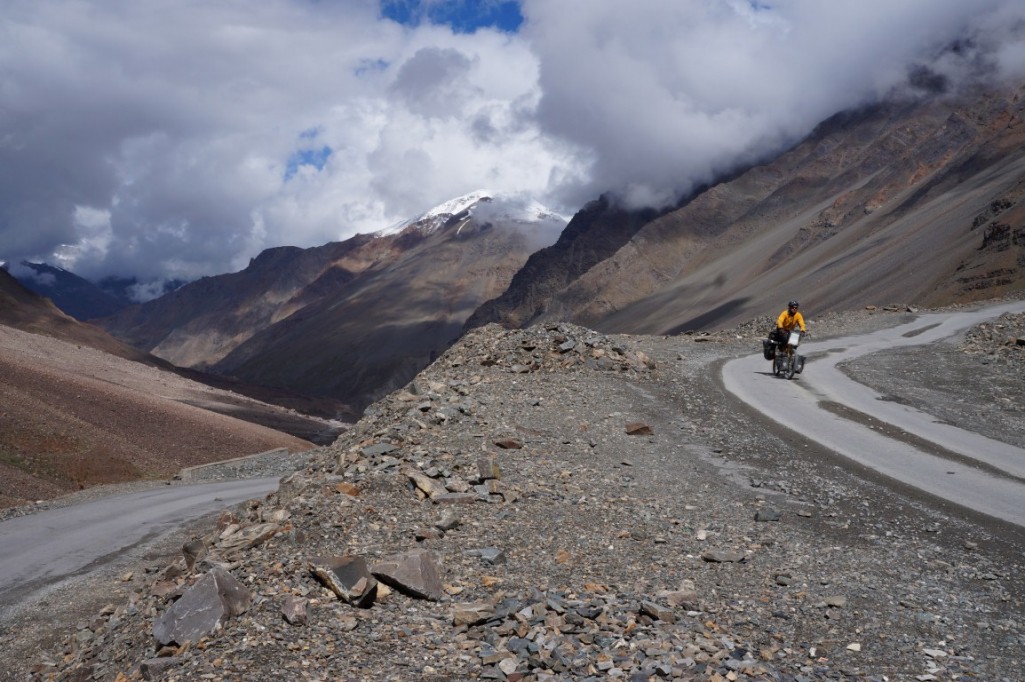


The stark coloured rocks of the high altitude roads are slowly being smothered by vegetation, waterfalls, streams and lakes. Eventually it gives way to a full alpine view with thick pine tree forests and fields of grazing sheep and goats. Although this area is sometimes cut off in winter there are now permanent dwellings and even a proper hotel or two. It feels like we’ve emerged from the wilderness.


A couple of short climbs keep our legs in check and allow the rims to cool down after the lengthy descent, then we arrive in Keylong, our first proper town since Leh which we left 9 days ago. We gorge ourselves on WiFi and curry.

While pushing the bikes through a section of deep sand on a climb after Keylong the next day we meet a French cyclist who gives ominous news of the road ahead. Our plan is to turn off the main highway towards the Spiti Valley but we’re told that the first 60km of this road will be ‘une mare de nuit’. The dusty road we’re on is no dream either as the fine sand is constantly kicked up into our faces by the passing cars and trucks.

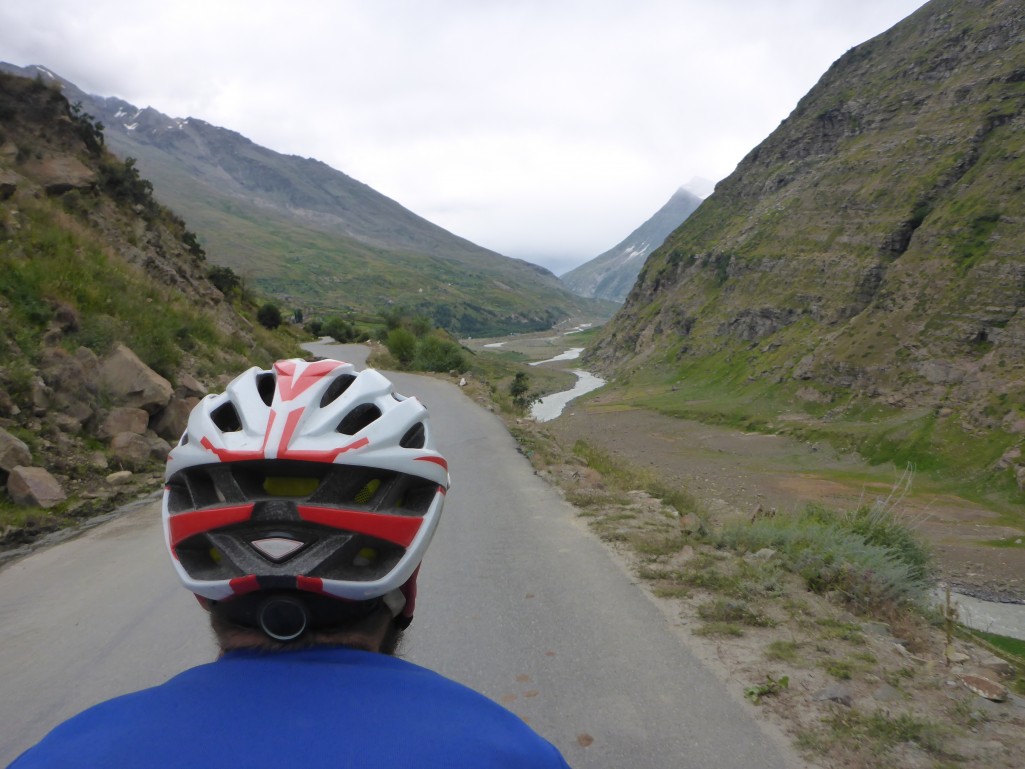
The steep valley on either side of us has impossibly perched fields and grazing stock that ought to be secured to stop them sliding down the cliff. After the climb the road rolls nicely on with a few undulations until we reach the base of the final climb of the Leh Menali Highway, the Rohtang La. We have the now familiar sight of the road turning into a rough track and ramping upwards but we get our heads down and begin winching up.
The Rohtang La peaks at 3978m and from the top there’s a 2000m descent down into Menali. We’re only taking on the first 5km of this beast of a climb though and turn off at Gramphoo. This is the beginning of the road towards the Spiti Valley.

After a short way we spot two small tents with two touring bikes parked alongside. They belong to two Englishmen, Mark and John so we ask if we can join their campsite. Although Mark lives in Tokyo and John in Paris they always manage to meet once a year for a 3 week cycling trip in some beautiful parts of the world. We share advice on where they should go next while they in return offload medicines and food supplies that they no longer need. As the night draws in we can see the headlights of trucks and cars slowly crawling up the pass high above us and the clear skies reveal a dazzling display of stars.

In the morning we face the nightmare road and we quickly realise two things: progress is going to be so slow that we’ll never manage the 63km to the Chandra Tal lake that we were aiming for in one day. Secondly, the boulder strewn road is not helping Kirsty’s sensitive stomach as she’s launched off the saddle and bumps back down again every few seconds. She decides to try and get a lift and we’re fortunate that two cars pull over soon after we’ve stopped. To lighten the load we take off the front panniers and rack bag and they are strapped to the roof of the car while Kirsty is wedged into the back seat. I’ll be continuing on the tandem on my own for this section.


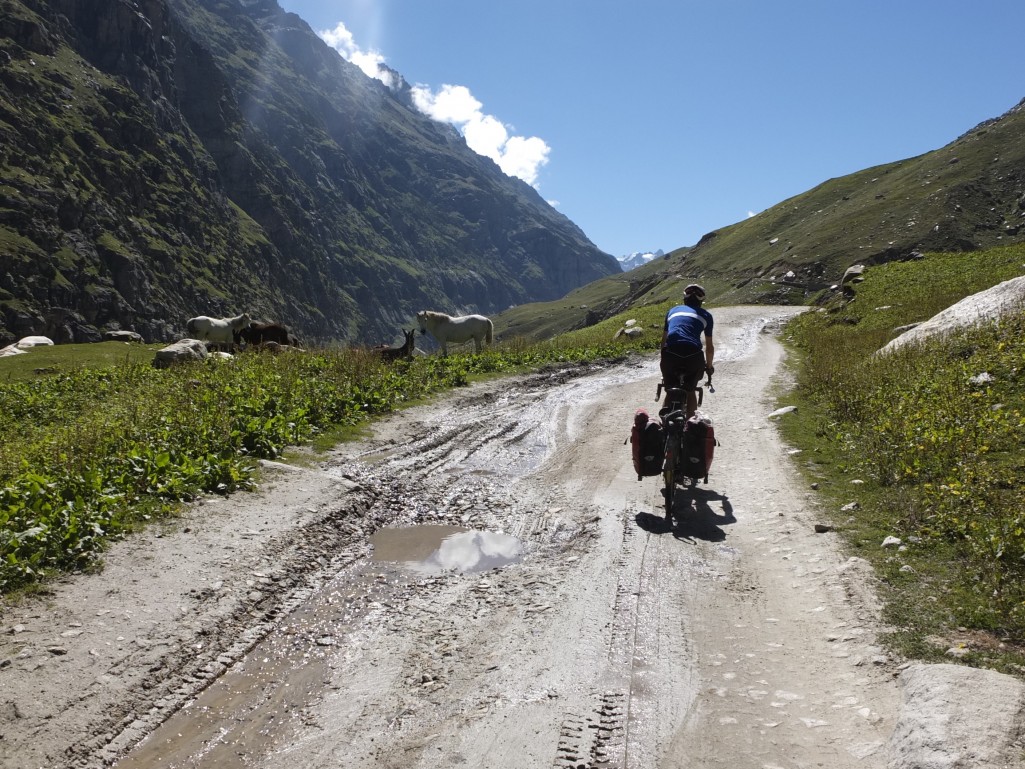
Kirsty speeds off in the convoy while Tara and I continue tackling the challenging road. One comment from Himalya by Bike is that “..the road is so bad even the goats won’t walk on it…”. In some parts it’s a boulder field and in others we’re attempting to ride up a flowing river. Calling on skills learnt from my mountain biking days I manage to get through most of it while still on the bike but there are just a few soggy foot moments too when the rocks and water come together to throw me off.
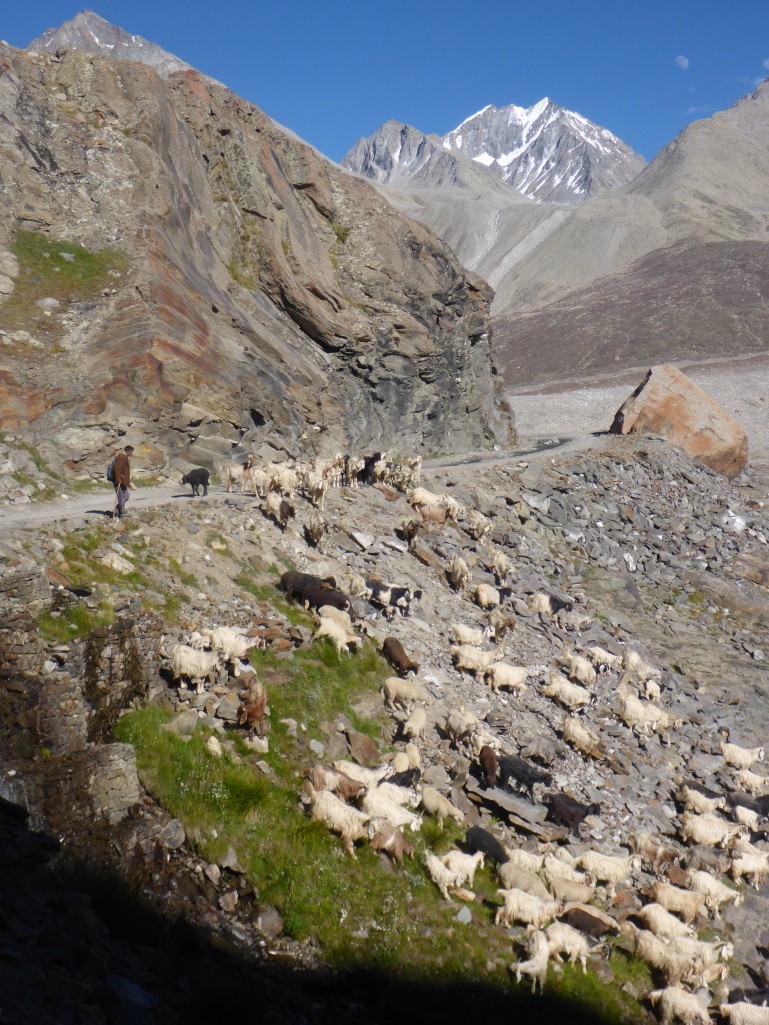
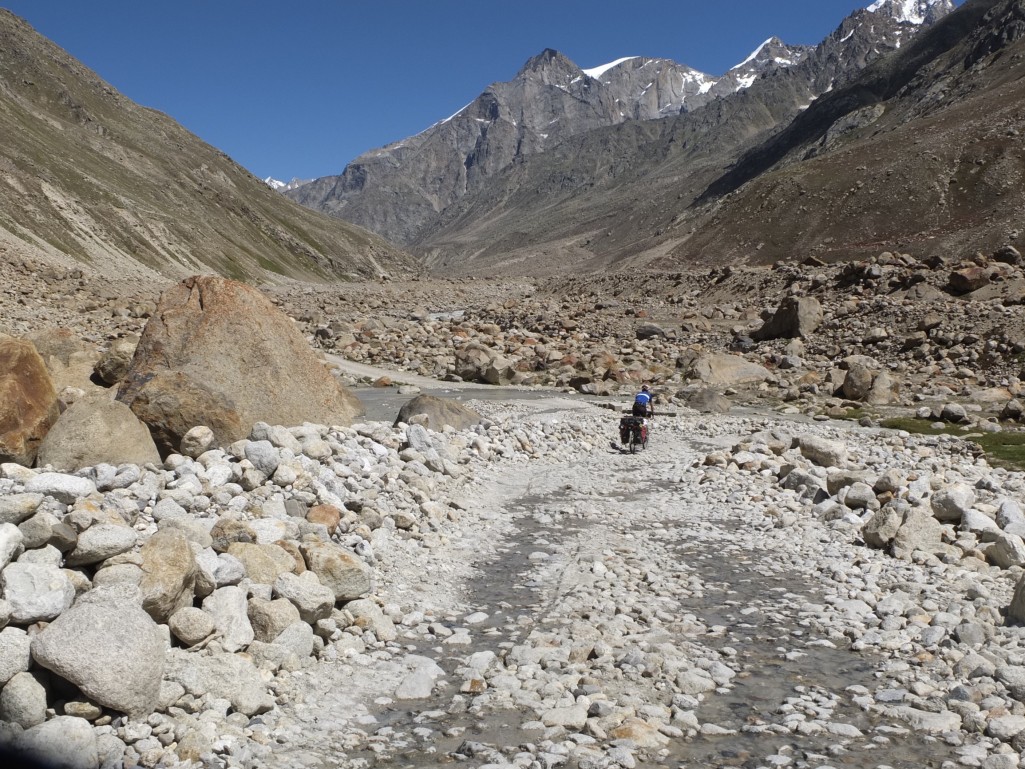

We’re both exhausted by early evening so it’s with a great deal of relief that we arrive in Batal, not only because we can rest our battered bodies but also because we can see that Kirsty has arrived safely and is waiting for us. Her journey was no less eventful as her car had to be pulled out of one of the streams by a 4×4 and then suffered a puncture. We eat plenty then bed down in the stone shelter alongside the dhaba.

In need of a short day we take a detour to Chandra Tal (Moon Lake) and set up camp on a hillside overlooking a number of glaciers tumbling down from high peaks. We share this idyllic spot with just a few horses but it’s hard to fully enjoy the moment. Kirsty has had a rotten couple of days with the sickness returning and compounding her feelings of having had enough of bouncing around on the back of the bike. These roads have been incredibly tough to ride on a double bike but doing it while sick has been even more formidable task.

The priority is for her to get diagnosed and get well while at the same time take a break from cycling.

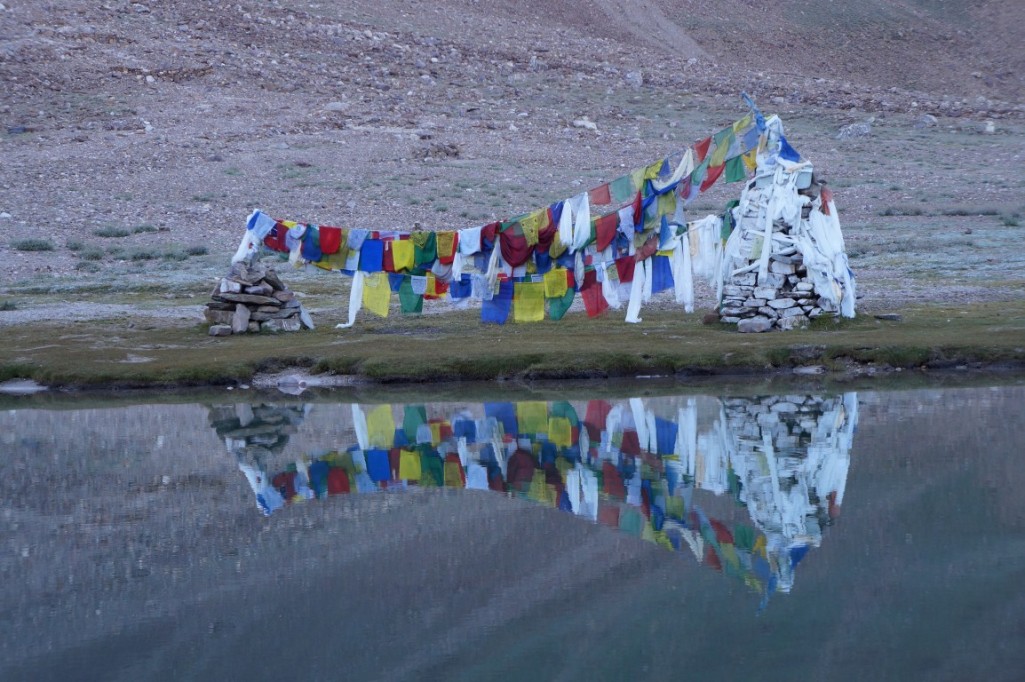
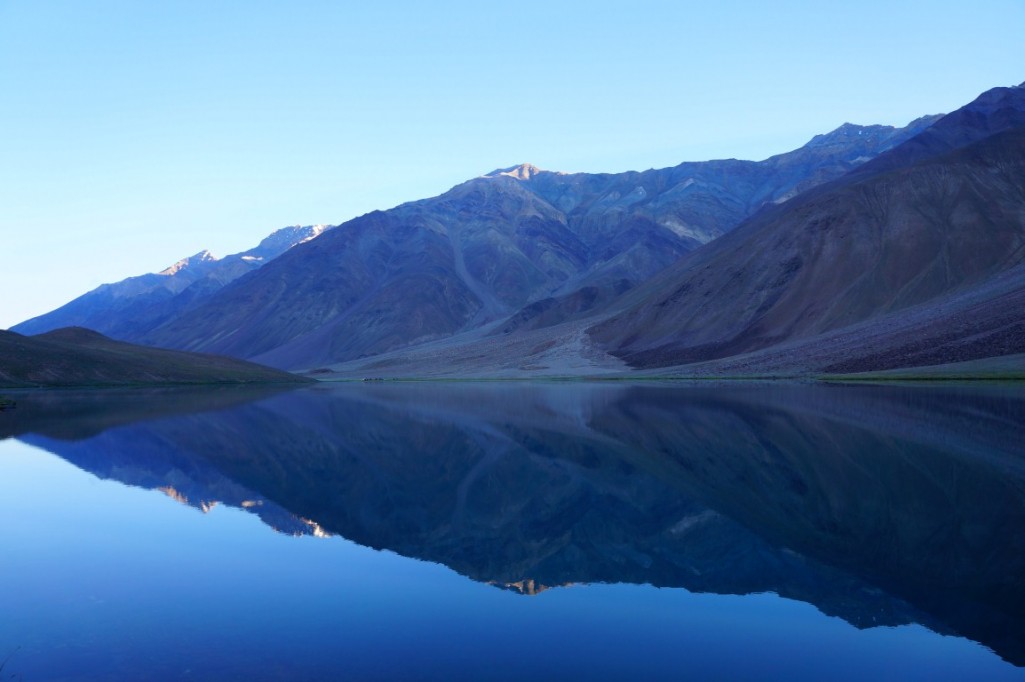
Kirsty insists that she goes alone to Menali to find a doctor and a hotel and there’s not much time for me to protest before she’s hitched another lift with a family heading in the right direction leaving me and Tara to ride on. We part company for the first time in over a year, aiming to meet up again in Shimla.

In a melancholic mood Tara and I scramble up the Kunzum La and complete the traditional kora circuit of the buddhist stupas at the top. Dropping down into the Spiti Valley is torturously slow but as many other cyclists had told us, the suffering is worth it to experience such a magnificent landscape.
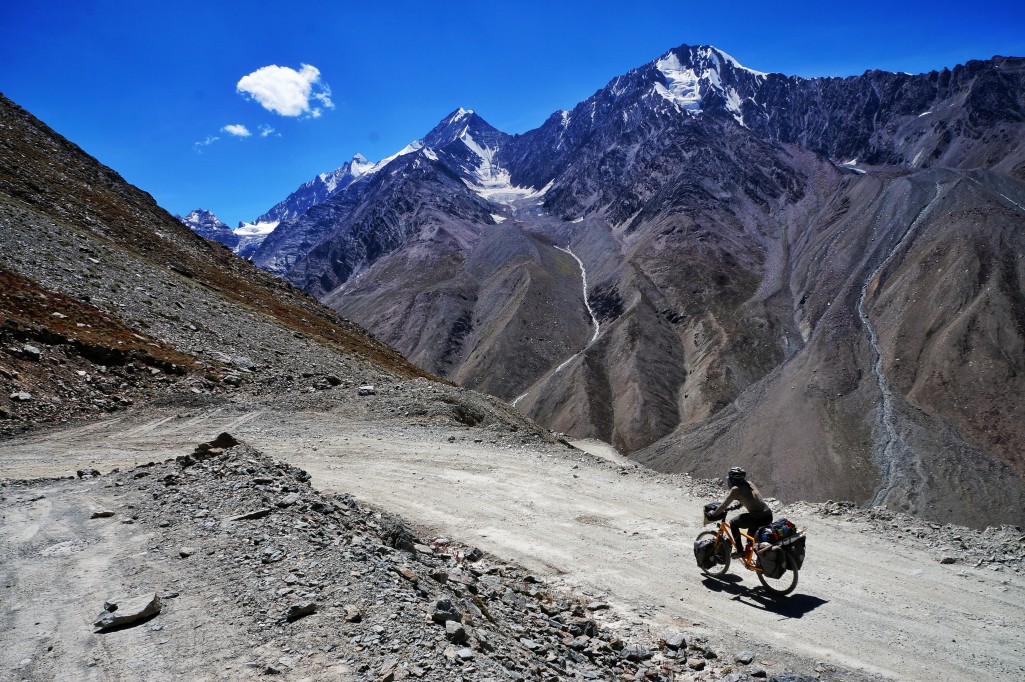
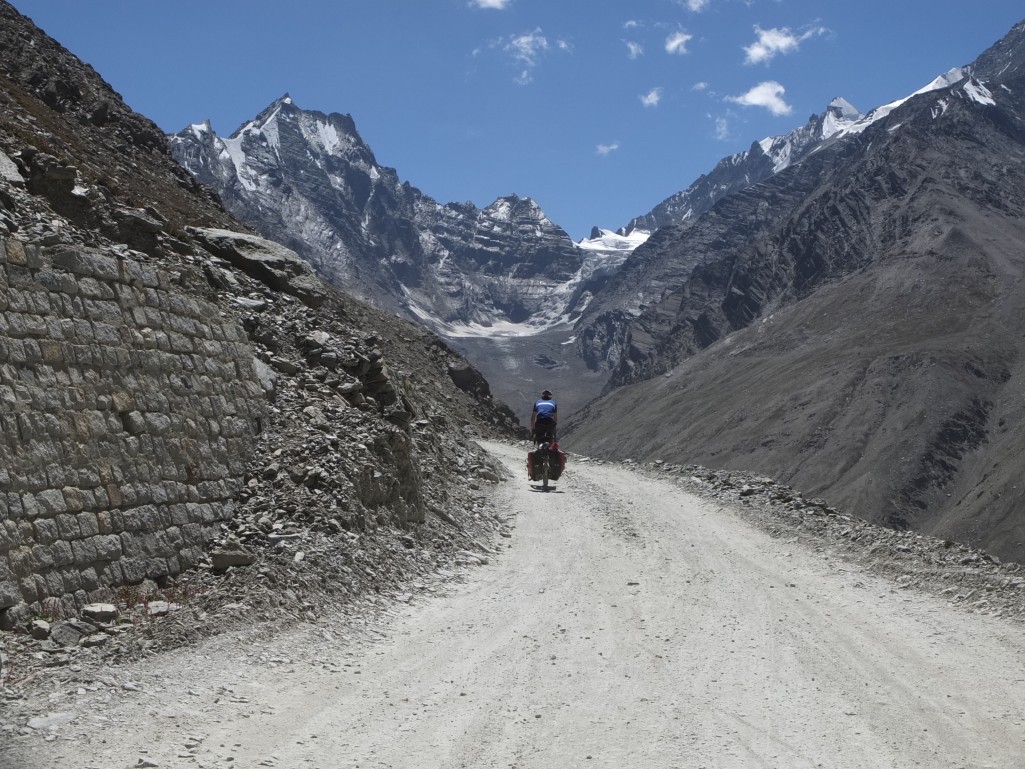
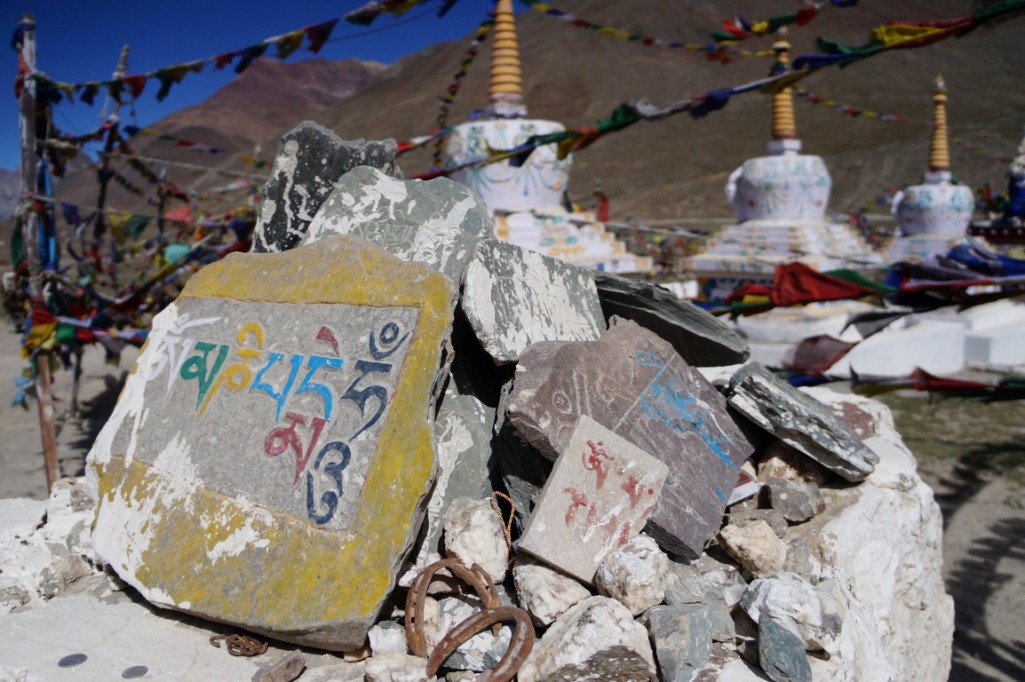
At several points along the road landslides have blocked the way but teams of JCBs seem to always be on hand to get the rocks cleared as quickly as possible so the delays don’t last long.

Pink pebbles line the mountain nalahs
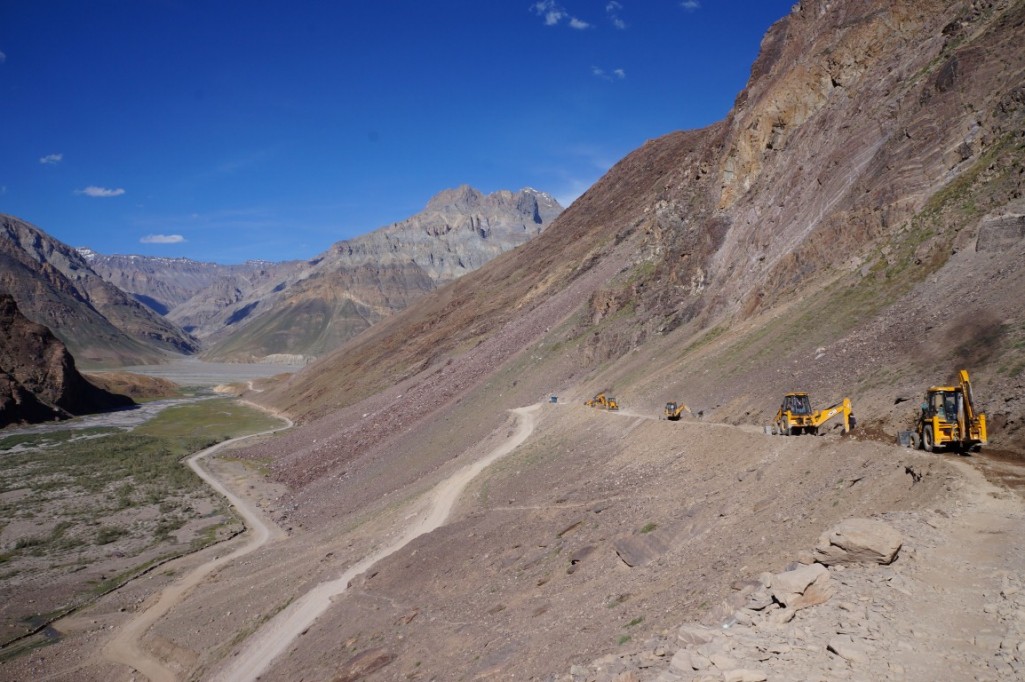

Spiti at last


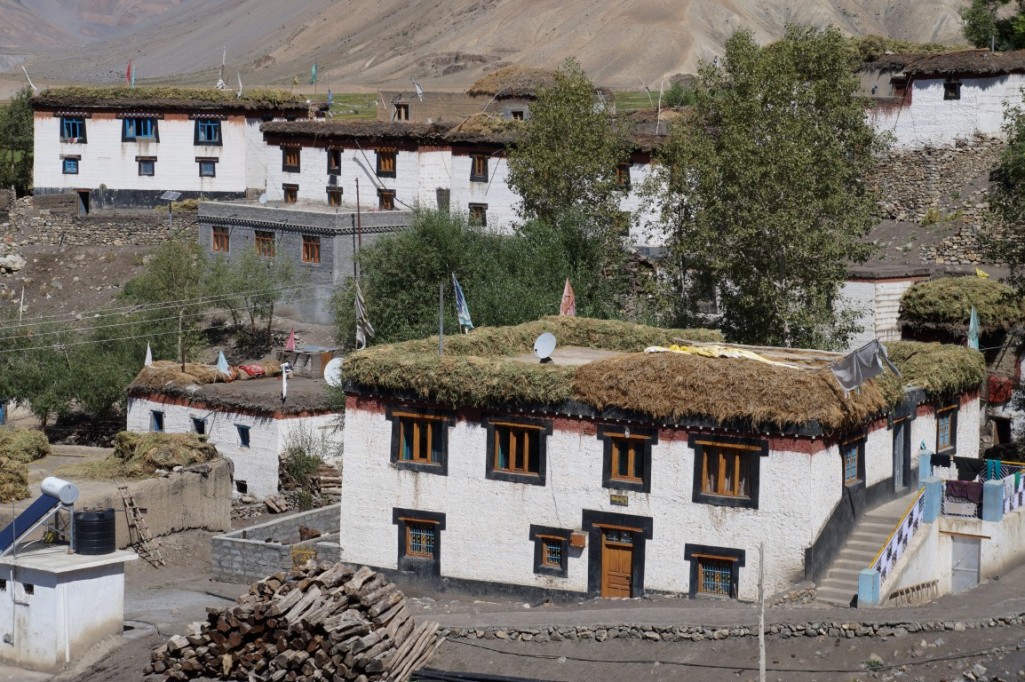
The Spiti River is like a mass of interconnecting streams, twisting around each other with no defined main channel. Gulleys are lined with pink rocks and enormous scree slopes threaten to form another blockage in the road or bury whole convoys of trucks without a trace.
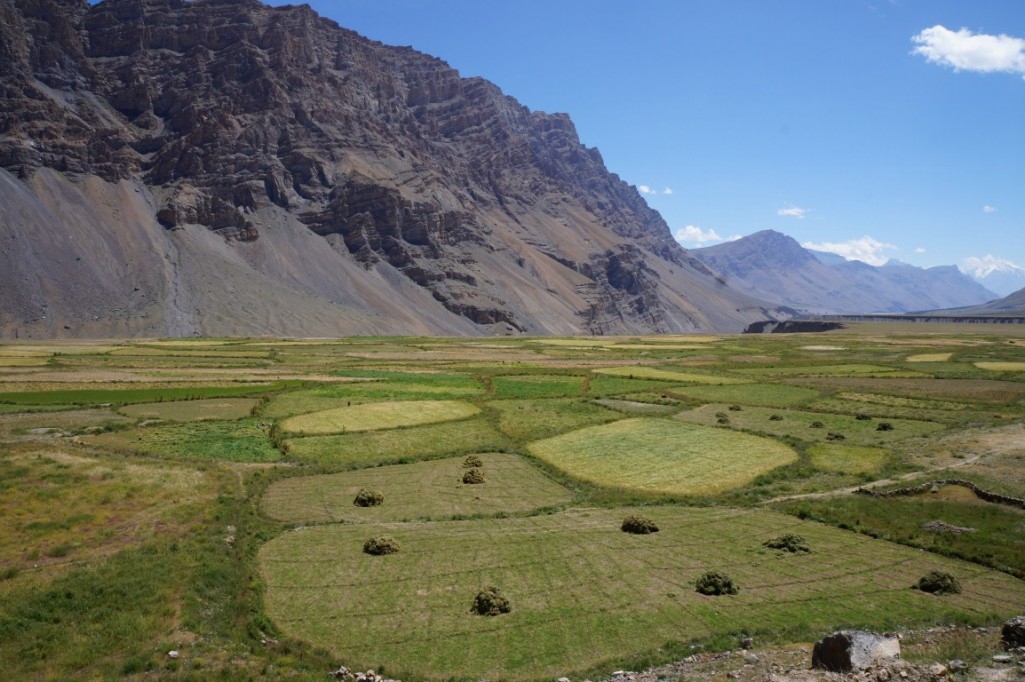
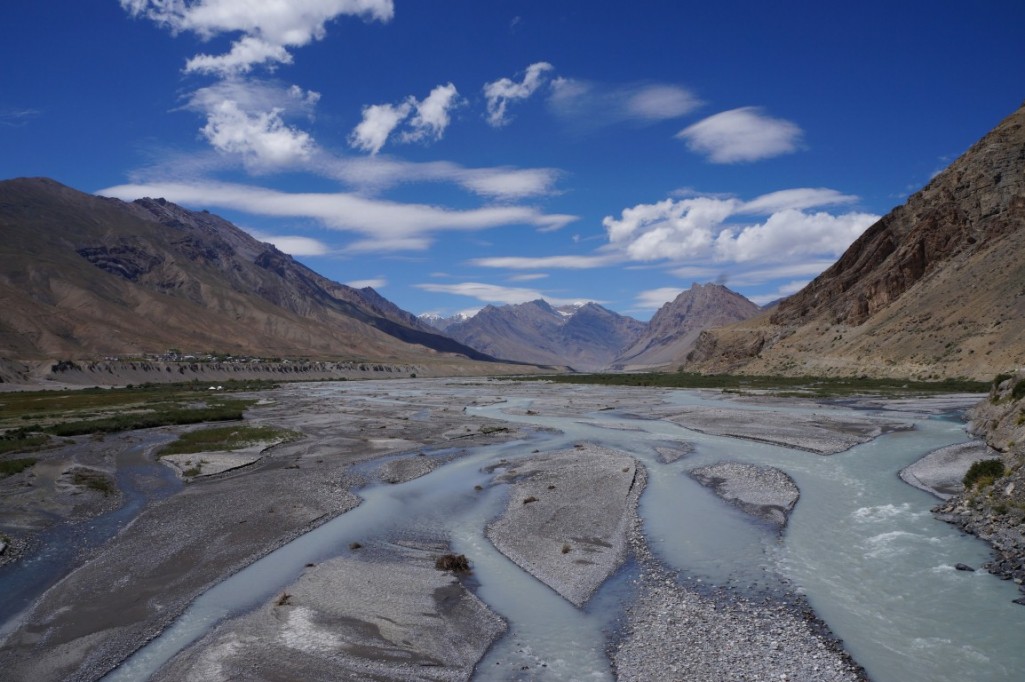
There are several monasteries and nunneries with many perched high on the mountainside to give inspiration and solitude to the inhabitants’ meditations.

While taking a rest day in Kaza we catch a lift up to Key Gompa and witness the morning prayers. It’s a fascinating experience with rythmic chanting accompanied by the occasional beat of the drum, ringing of bells and blasts from a horn. As it progresses various accessories are added by the monks, from coloured ponchos to conical hats finishing with an elaborate gold fan to form a tiara round their heads. Even some of the monks seem to be finding it hard to keep a straight face when they look at each other.

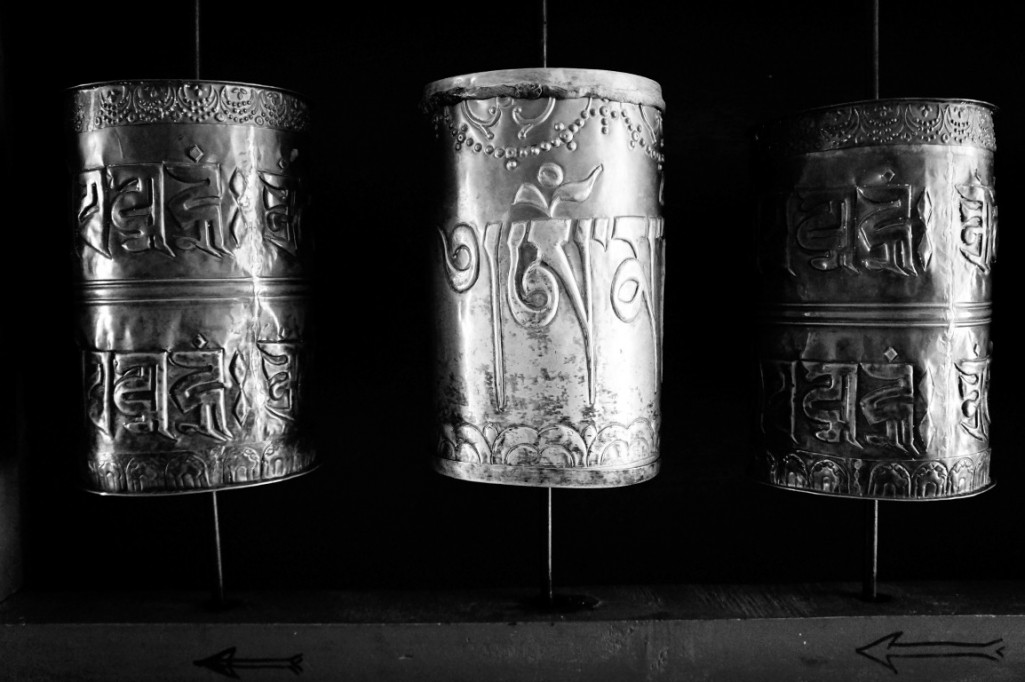

In Kaza we collect our Inner Line Permits from the well hidden Additional Deputy Commissioner’s office. It costs nothing but allows us to continue on the road ahead that comes very close to the Tibetan border. If we manage to cross the deep gorge, swim the river, evade the Indian army, cross into Tibet, evade the Chinese army and start an uprising then they’ll know who we are.
I also manage to contact Kirsty who is on a course of antiamoebic drugs and beginning to feel better. I buy some of the same as although my bouts of illness haven’t been as severe as Kirsty’s, it does keep coming back in a similar cycle so I’m keen to get rid of it for good too.
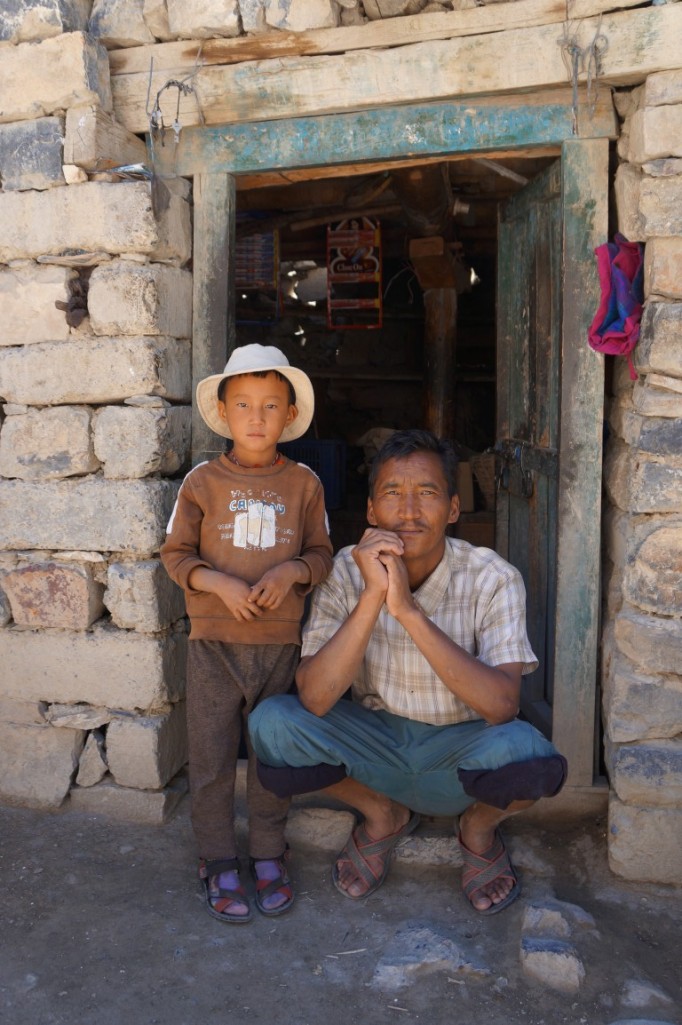

After Kaza we spend a night in the dorms of Tabo monastery and join the monks for their morning prayers. It’s not just us that are yawning given the 6am start, some of the younger monks are only 6 years old and struggling to stay awake. Founded in 996 AD this is the oldest continuously serving buddhist monastery in the Himalayas and there are some incredibly vivid murals preserved in the gloomy rooms of the mud-walled buildings.
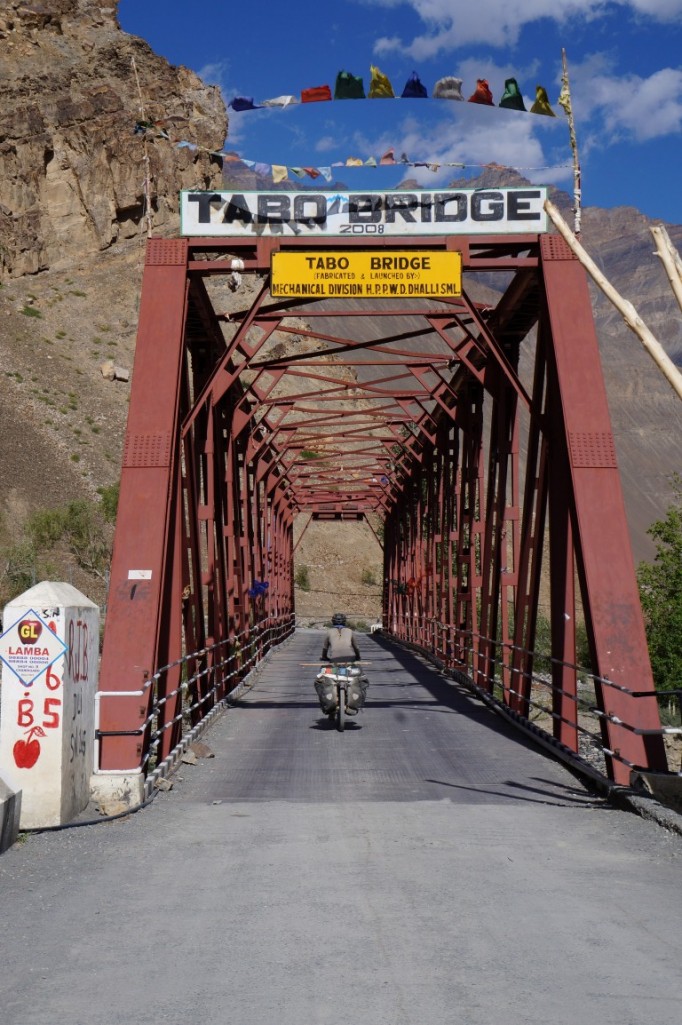


A rare treat of 30km of paved road takes us to Sumdo, the checkpoint for the Inner Line Permit where we enjoy some samosas in the army canteen. The soldier who looks after us while we eat describes the land 2km to the east as “..Tibet, captured by China..”. The communities on this side of the closed border include families that have been divided by the Chinese occupation. Their relatives are on the other side of the range of mountains right next to us but it’s unlikely they’ll ever be able to cross over to see them ever again.

The road gets worse again, damaged by yet more landslides. There are plenty of men and women kicking stones around in an attempt to improve it but it looks to be a slow process not helped by the fact that they also need to look after their children in what must be one of the most unsuitable workplace creches we’ve ever seen. The average wage for this job is just 300-400 rupees (£3-4) per day.
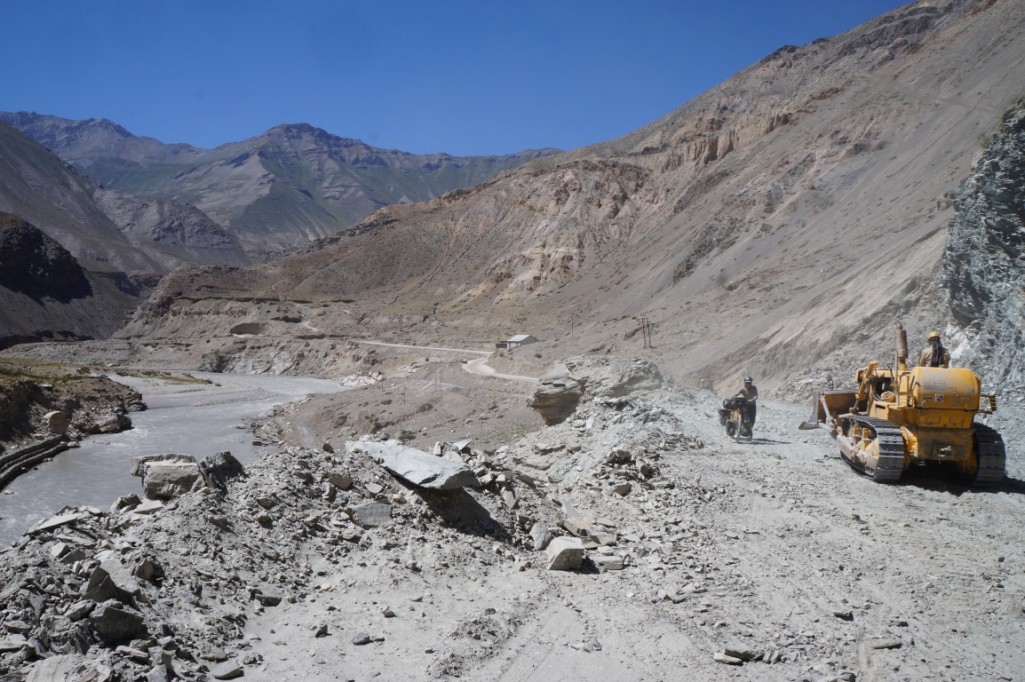
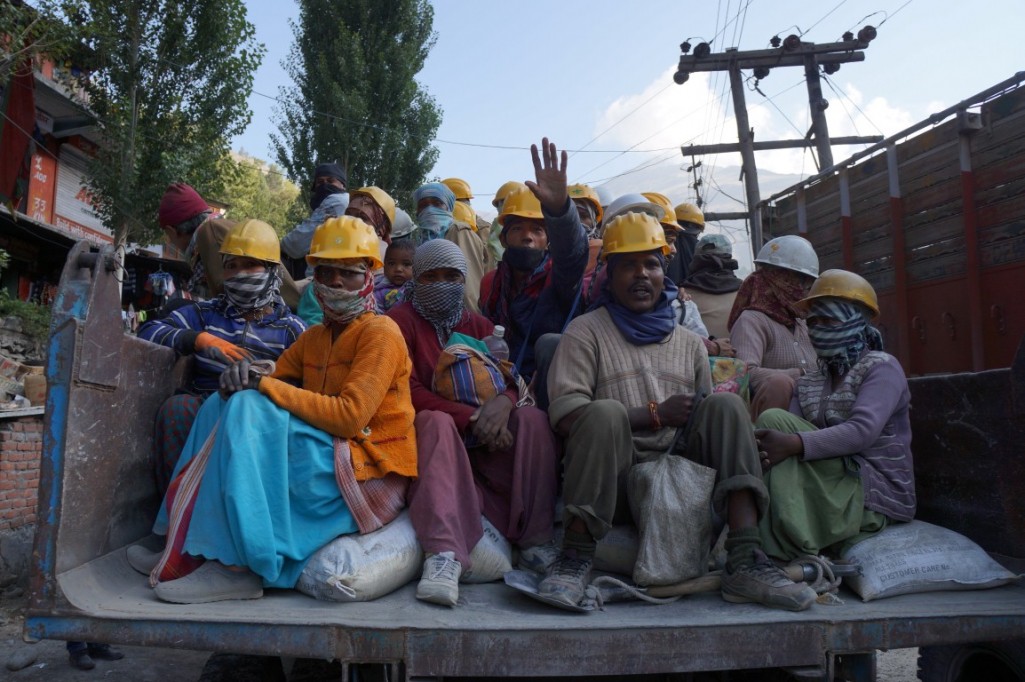
An arduous climb takes us to the pretty town of Nako which clusters around a manmade lake and is surrounded by fields and orchards. Apart from this oasis the landscape around us is elemental, just rock and water on a scale that is hard to comprehend.
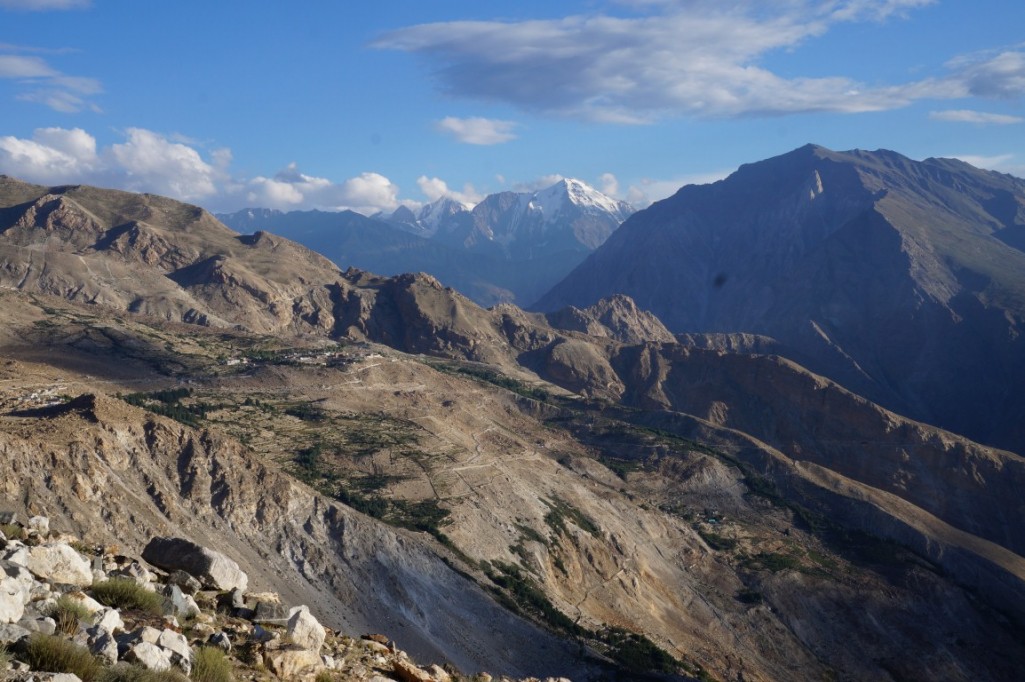
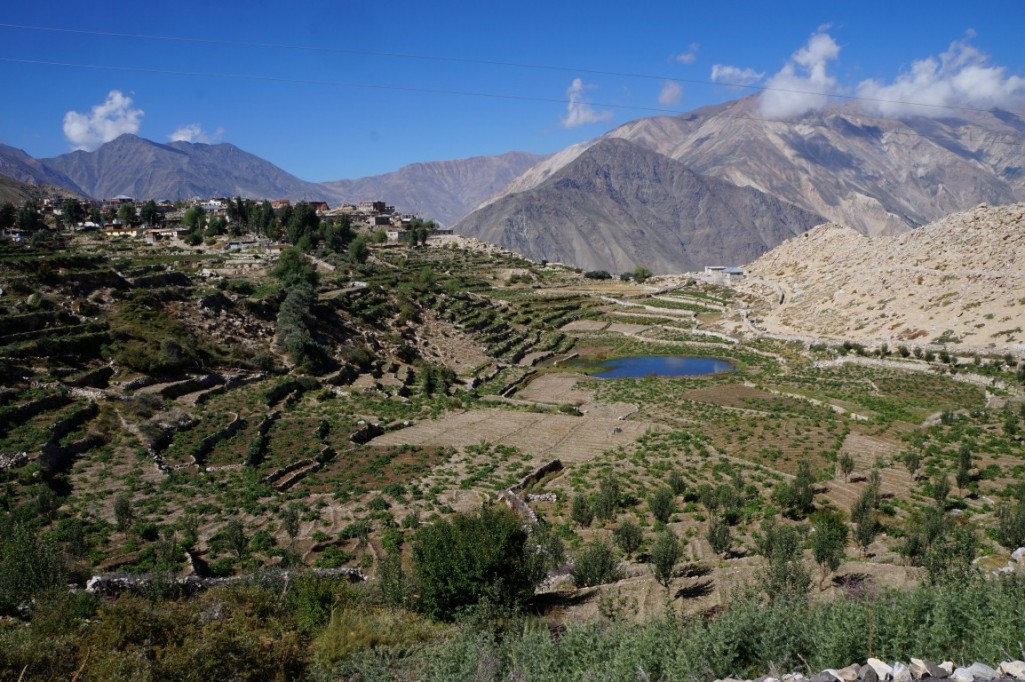


Down from Nako we follow the river again. Through Dubling we pass tin shacks with wood being stockpiled in preparation for trying to survive what must be a very harsh winter. Just after the turn off for Pooh (no bears seen) we’re beckoned into a roadside booth at an army base, expecting a routine passport and permit check but in fact getting a cup of tea and some fresh pears. The soldier explains that it’s just a nice gesture they offer for passing travellers.

We spend the night in ‘The Little Chef’ in Spillow. Sadly they don’t have an Olympic Breakfast but while we eat pirantha and fried eggs in the morning we sit and chat with Karl who we’d crossed paths with a few times over the last two days. He’s travelled through many parts of the world by bike and at the age of 68 is still hungry for more adventures. Provided you still have the desire there’s no reason to stop doing what you love just because you’re not as young as you used to be.

We seem to be on the wrong road when we leave Spillow. Not only is it smooth with asphalt, there are two lanes and a white line painted down the middle. This is the first ‘proper’ road we’ve seen for several hundred km. It lasts for a glorious 20km before the more familiar rocks and sand return.
We leave the ‘Inner Line Permit’ area as the road turns west and away from the Tibetan border. Dropping down further we see more trees, more colour, cows, saris, hear the sound of hacking and spitting and the temperature rises. We’re entering ‘India’ again.


The chocolate brown Sutlej river rages below us, picking up tributaries from the mountains and gathering pace. There are huge hydroelectric plants built into the hillside. 1/4 of India gets its electricity from Himachal Province thanks to water and gravity.
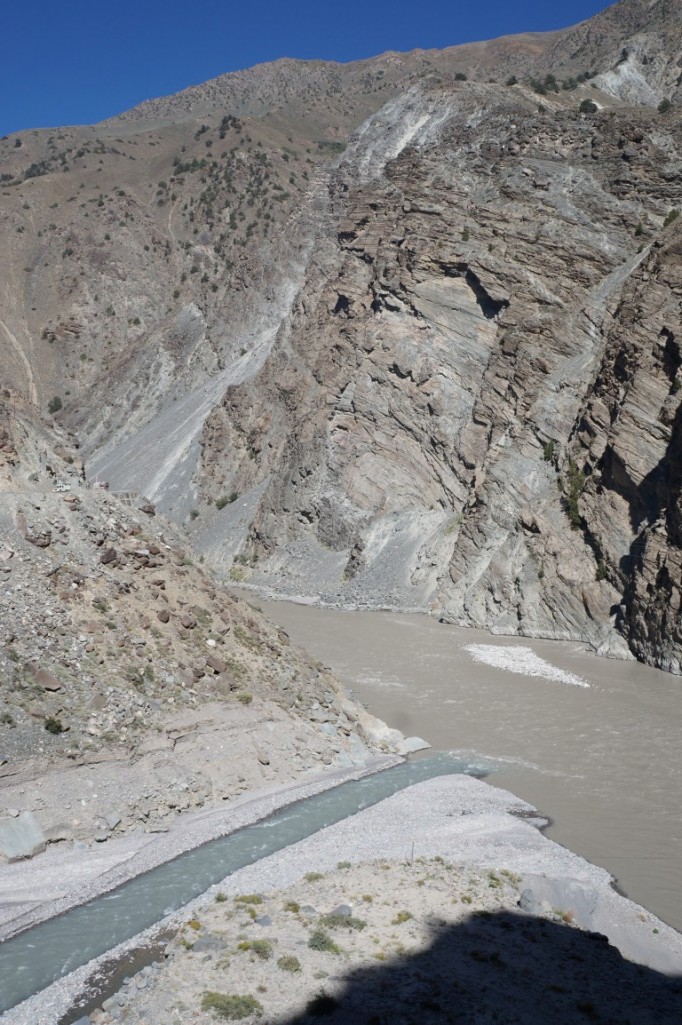

A new power plant is being constructed south of the village of Chilling but drilling for the pipelines last summer caused a landslide that destroyed the main road below. The resulting diversion is still in place and involves an extra 15km and a 600m high steep climb which we take on begrudgingly. On the way up we pass troops of monkeys and verges filled with Marijuana then the small reward is a view back down to the valley below, where we should have been riding.
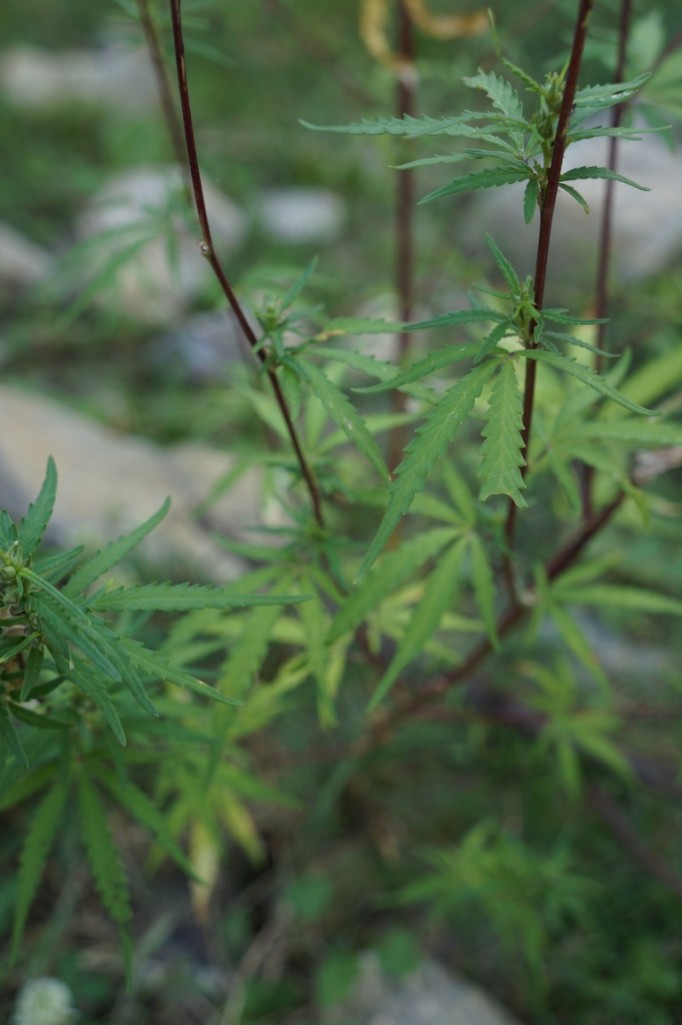
My front brake cable had snapped while I was trying to tighten it up earlier in the morning, thankfully while stationary and thankfully before the long fast descent into Tapri that we now enjoy.

Finding some WiFi I manage to catch up with Kirsty who is on the decline again and still in Menali. The course of pills had only had a temporary effect and she’s feeling worse than ever. Our rendez-vous in Shimla can’t come soon enough.
We’re in the Kinnaur Valley now which is a road builder’s nightmare. Near vertical cliffs leave no option but to carve a notch in the rock which is our pathway through this stunning valley. Trucks and buses squeeze under the overhanging rock with nothing but a slim armco barrier or the occasional concrete block to catch them if they get too close to the edge.
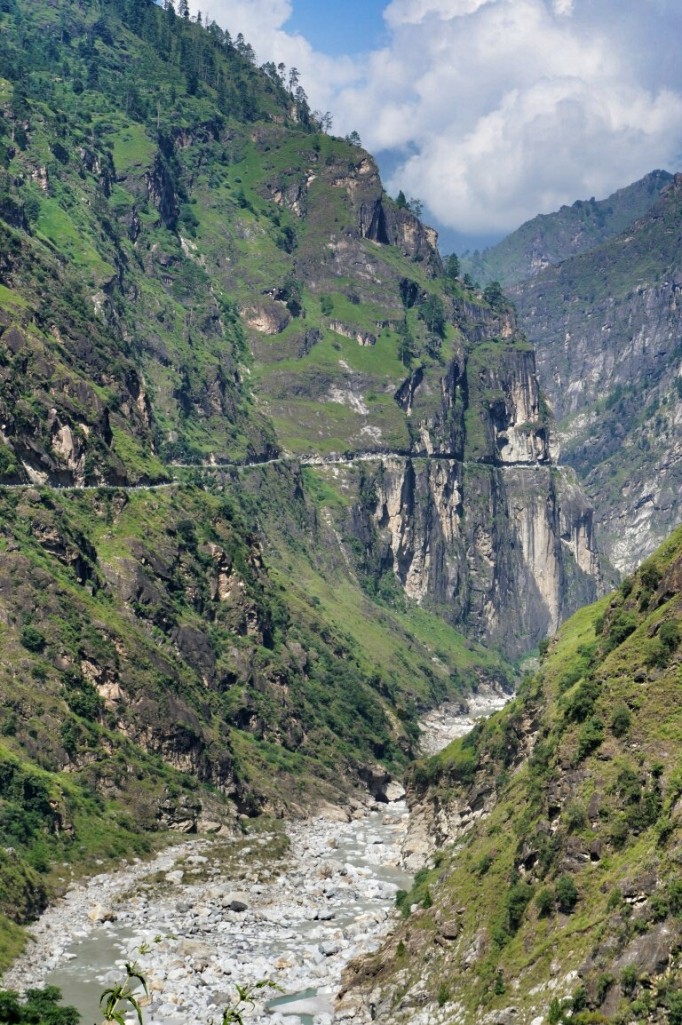
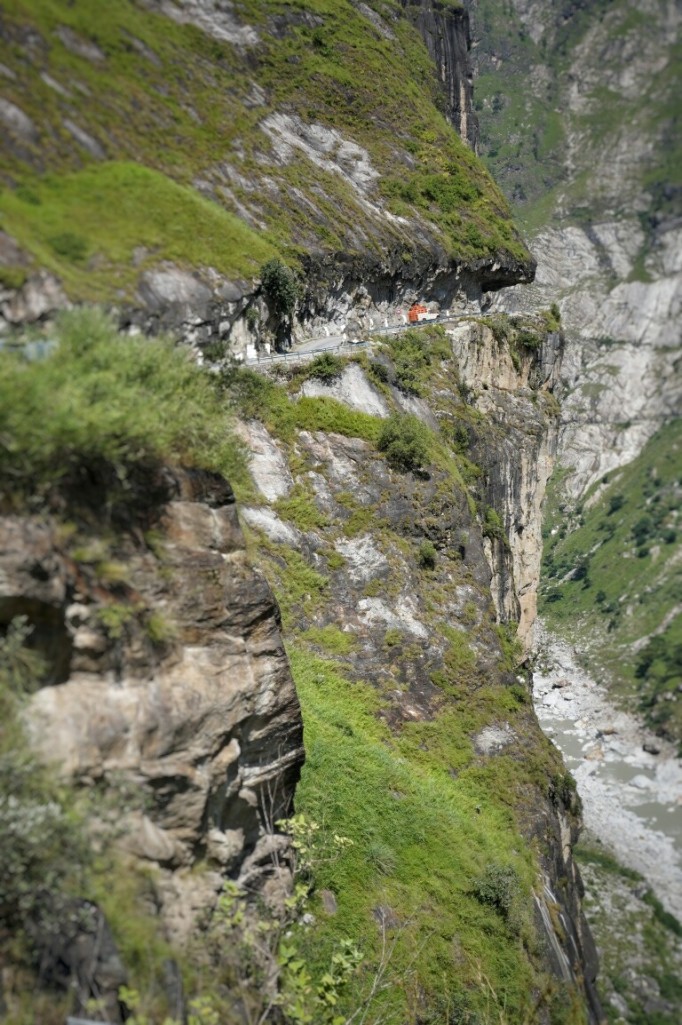

At Jeori, we decide over an ice cream to hitch a lift up to Sarahan where we stay in the basic dorm of the Hindu Bhimikhali Temple. A snoring Swiss backpacker makes for a restless night’s sleep that is brought to an abrupt end by the morning prayers being broadcast at high volume from 4am. But we’d planned an early start anyway and hit the road at 6:00am as we want to make good progress today.
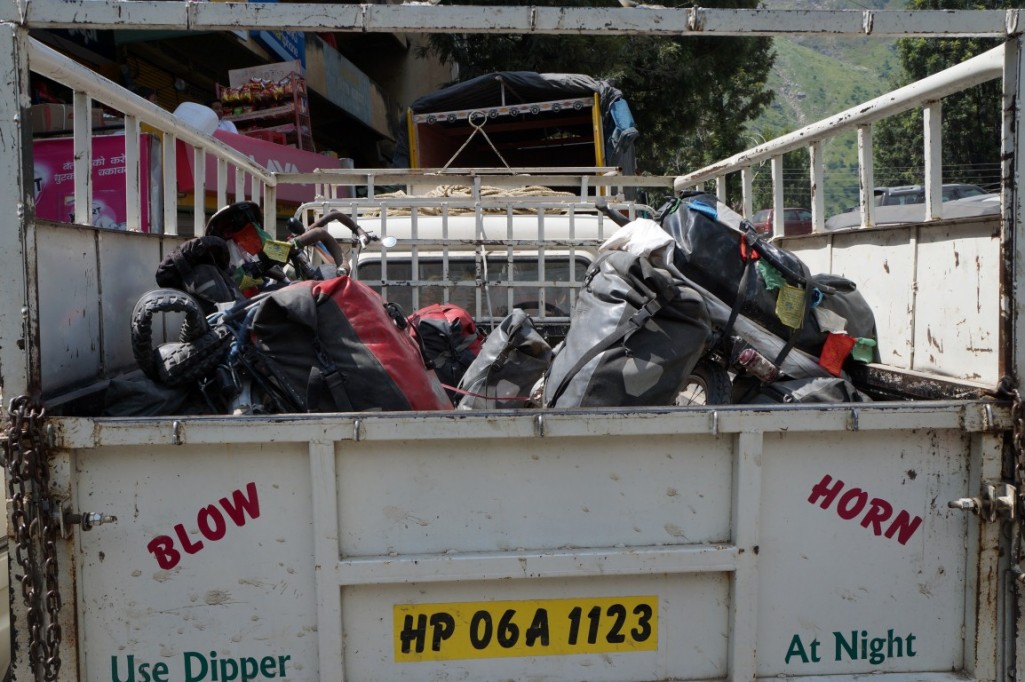



The morning sunlight creeps down the mountainside as we plunge back to Jeori for a quick breakfast. Then onwards and downwards for most of the morning. The roads are busy with vehicular, pedestrian and bovine traffic and as we pass through each hectic town the utmost concentration is needed to make it through safely.


By lunchtime we’ve covered 70km and stop to refuel and rehydrate. The air is hot, humid and thick with oxygen. We can almost drink the air and both Tara and I feel stronger than ever having been up high for so long.
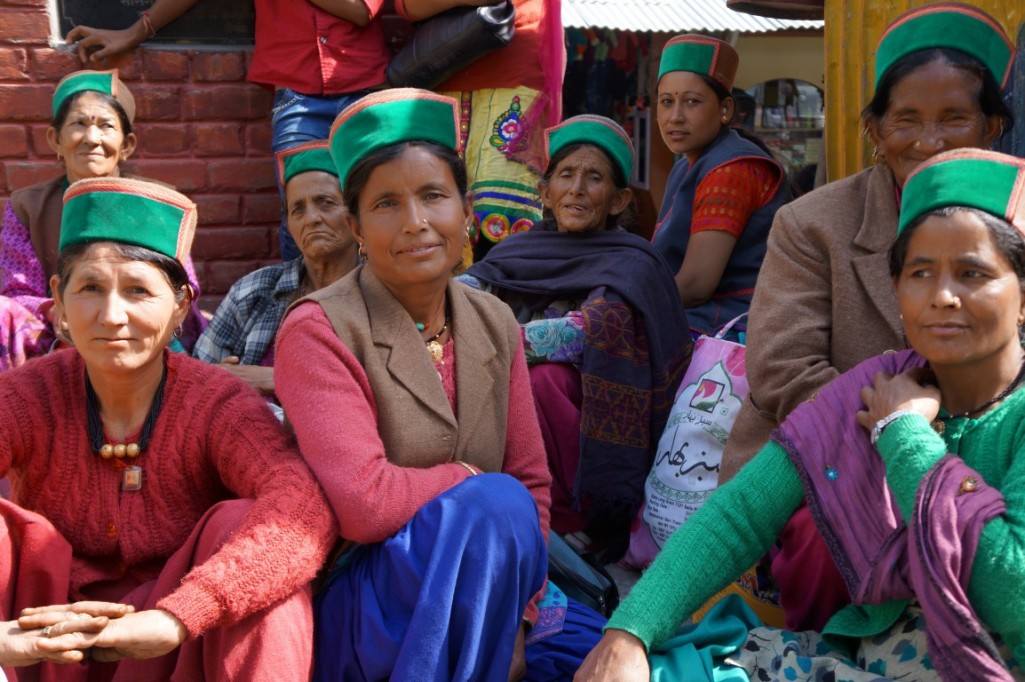
Which is just as well as the afternoon will be spent climbing up to Narkanda. A winding road for 37km that will take us from 900m back to 2800m. It begins in dense jungle and finishes in fresh pine forests steepening up towards the top with a broken road surface and curious monkeys watching from the branches of trees.


We arrive in the ski station town over 12 hours and 110km after leaving Sarahan at dawn and treat ourselves to a smart hotel and a huge dinner.
It’s then a pleasant ride along an alpine ridge line towards Shimla. Himachal is the fruit basket of India and it’s apple season at the moment. The roads are packed with hundreds of trucks laden with crates of apples picked from the vast orchards that line the slopes below us.
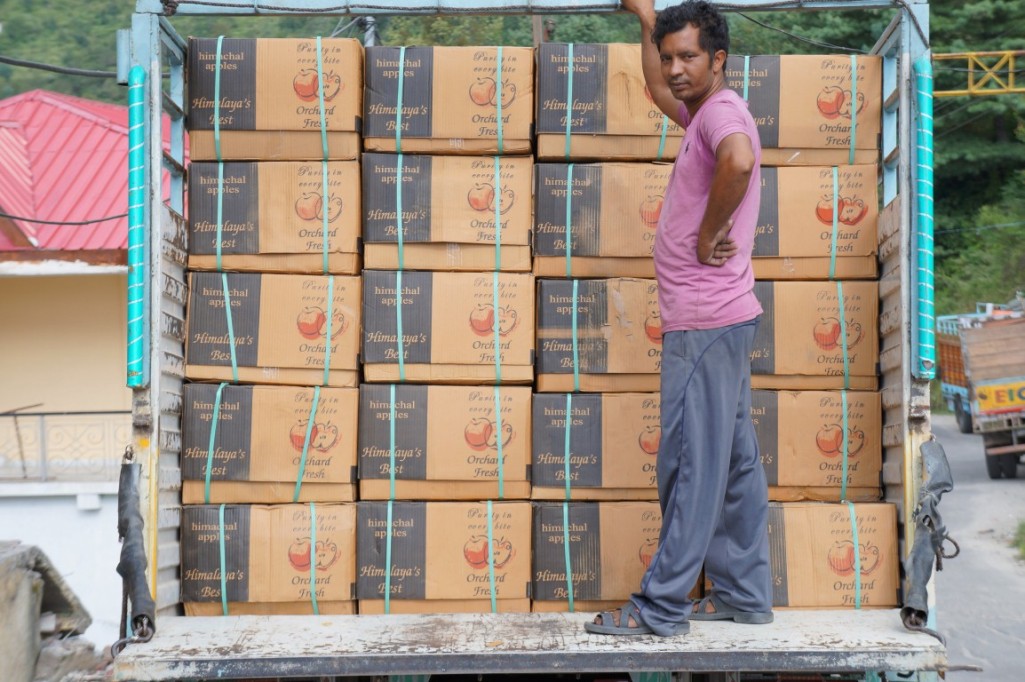


Battling with increasing volumes of traffic we finally arrive in Shimla and make our way up to the town centre on the ridge of a hill. Famous for being the summer capital of India during the British Raj, the entire government used to move from Delhi to this hill station to escape the heat from March to October. It has the feel of an English Spa town with the grand Gaity Theatre, a provincial church and a library that wouldn’t look out of place in Cheltenham.
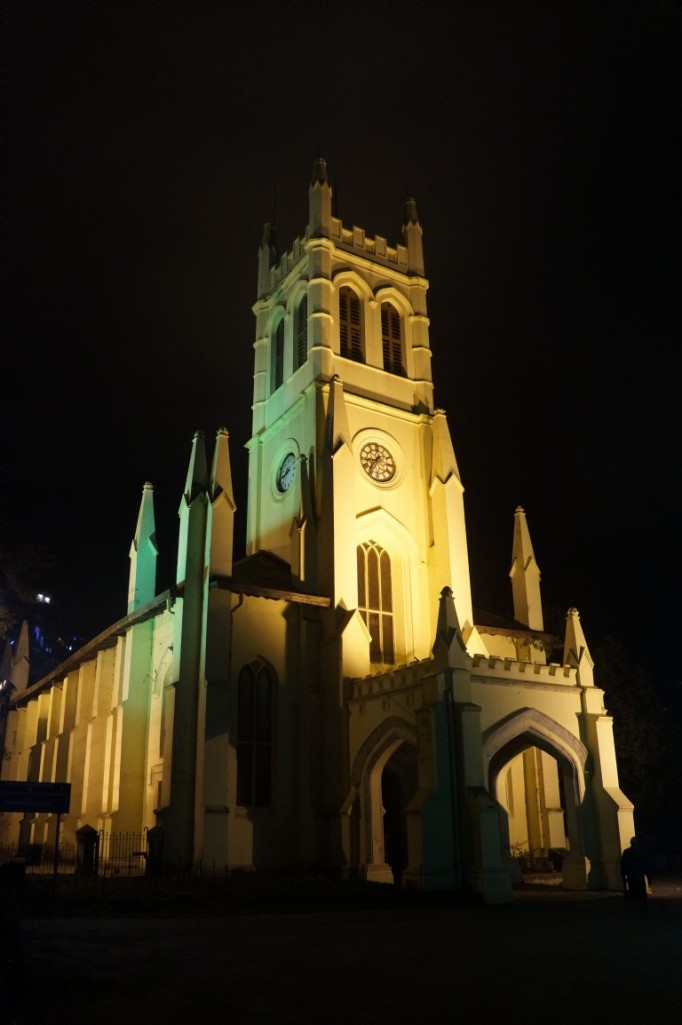
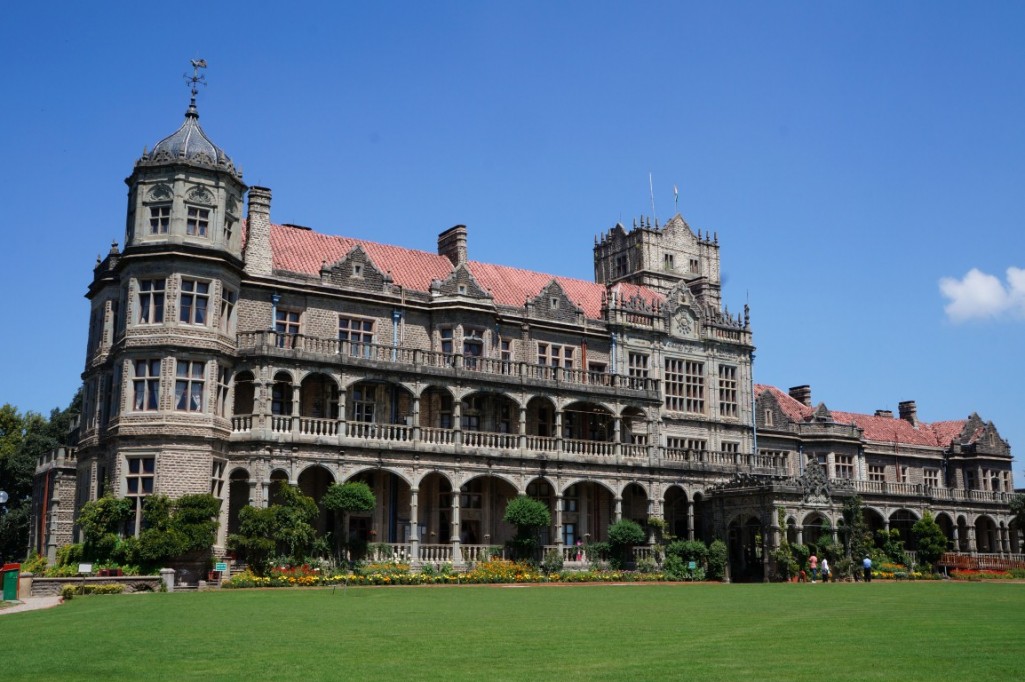
This is the end of our Himalayan odyssey, since leaving Srinigar we’ve ridden over 1500km and climbed somewhere in the region of 30,000m. We celebrate with the luxuries of pizza and beer while on the streets there are celebrations for Lord Krishna’s birthday.
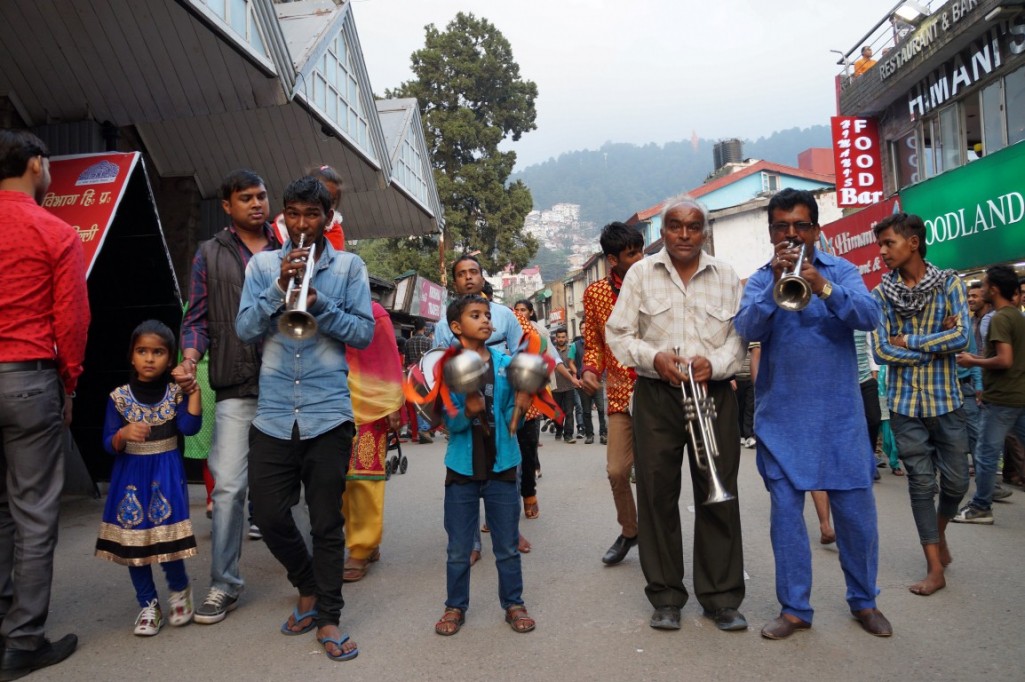

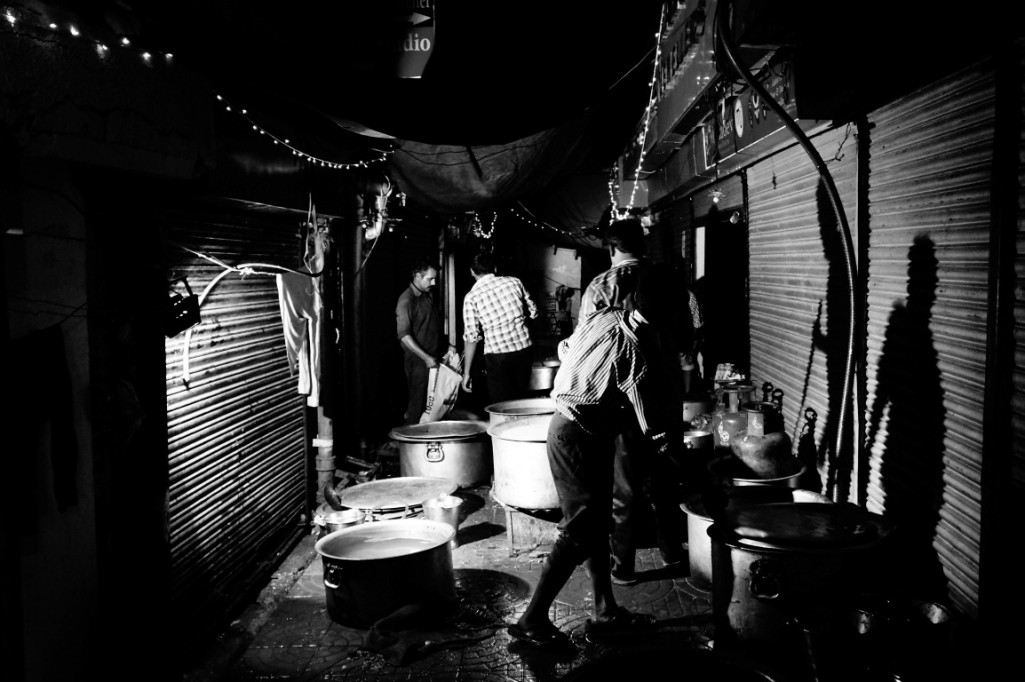
But the celebrations for us at least are slightly muted as there is still one member of the party missing. Kirsty was not feeling well enough to make the 8 hour journey from Menali so is waiting another day before heading across. It means she misses saying goodbye to Tara who has a flight to catch from Delhi in a couple of days. Tara leaves Shimla in the morning on the tiny ‘Toy Train’ that winds its way down to the plains far below. Her journey now will follow ours in reverse as she flies into Bishkek then takes on the Pamir Highway. After that it’s Cairo to Cape Town early in 2016 (www.followmargopolo.com). Hopefully we’ll ride together again but who knows where or when.
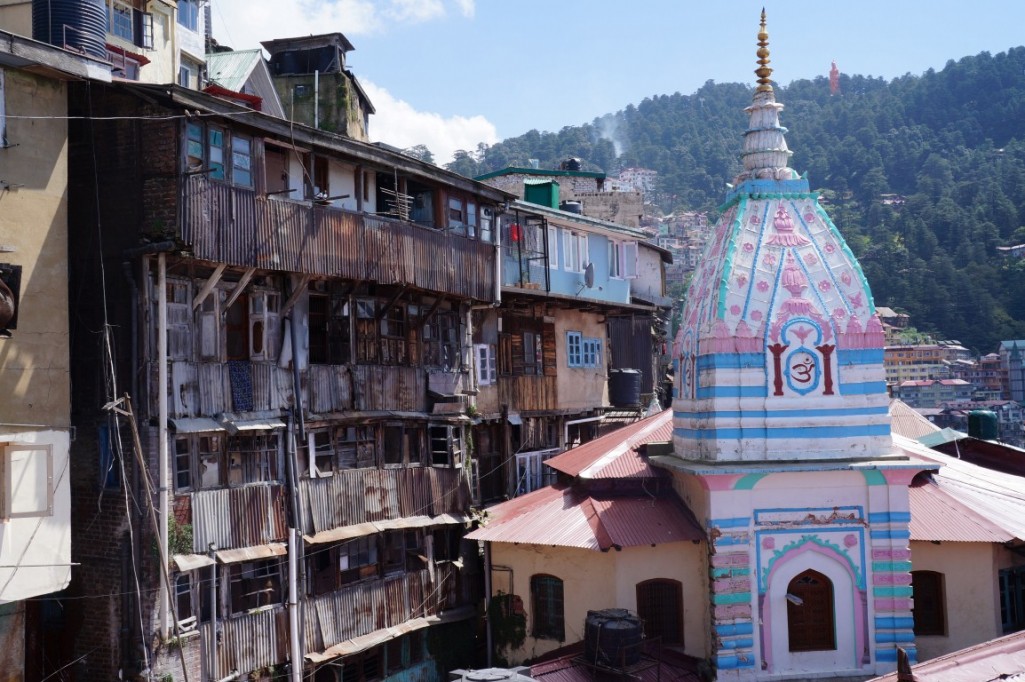
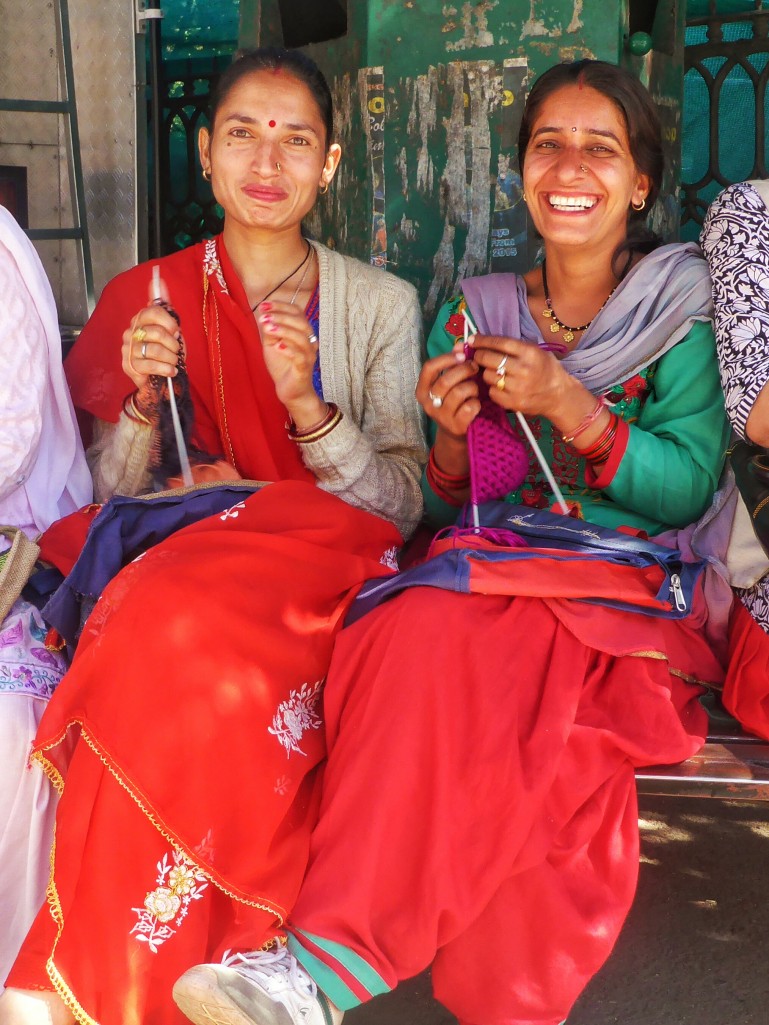
After 10 days apart Kirsty finally arrives by taxi that evening. I’m shocked by how gaunt and frail she looks. I think we both underestimated how serious amoebic dysentery could be and I can only imagine how awful the last week has been for her. She’s on yet another course of drugs prescribed by the doctor in Menali and so far she’s making good progress in that she can walk more than a few steps and eat, more than can be said for a few days ago.



Shimla provides a comfortable place to stay, good places to eat and monkeys for entertainment so we decide to stay for as long as necessary to get Kirsty back up to strength.
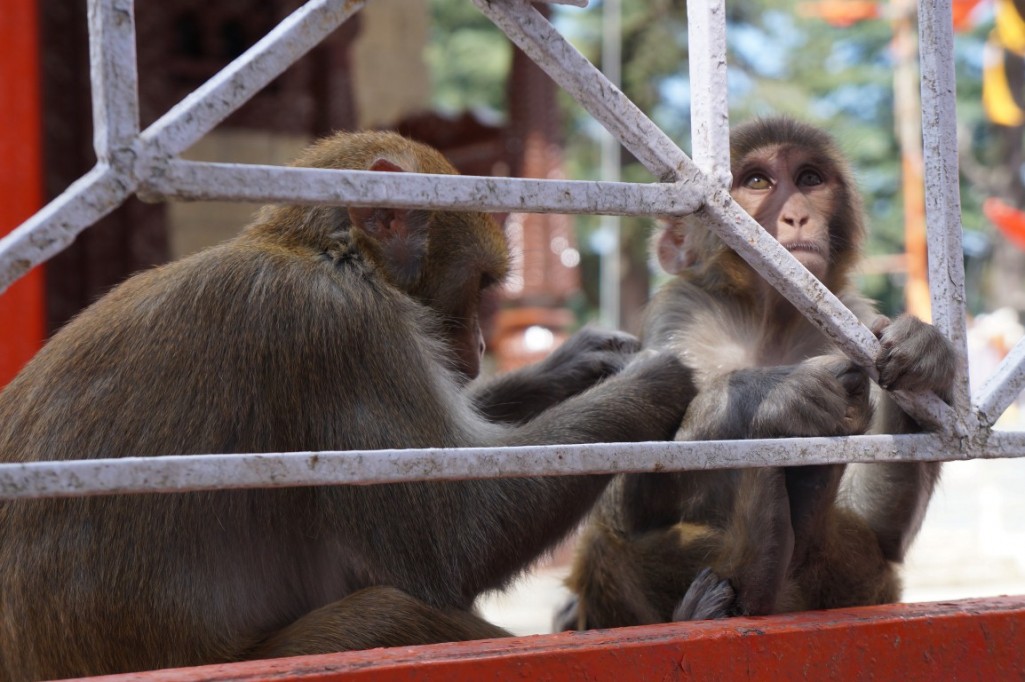




As we were warned, India shouldn’t be underestimated. Every day we’ve had moments where we have to stand and stare with a look of total awe at a landscape that verges on the surreal. But with the beauty comes the beast and carrying on such arduous riding while sick has taken a heavy toll. Physically and emotionally drained from the experience I should have recognised that we needed more rest but instead we pushed on. From this there is a lesson I hope to have learnt, particularly for Kirsty’s sake.




